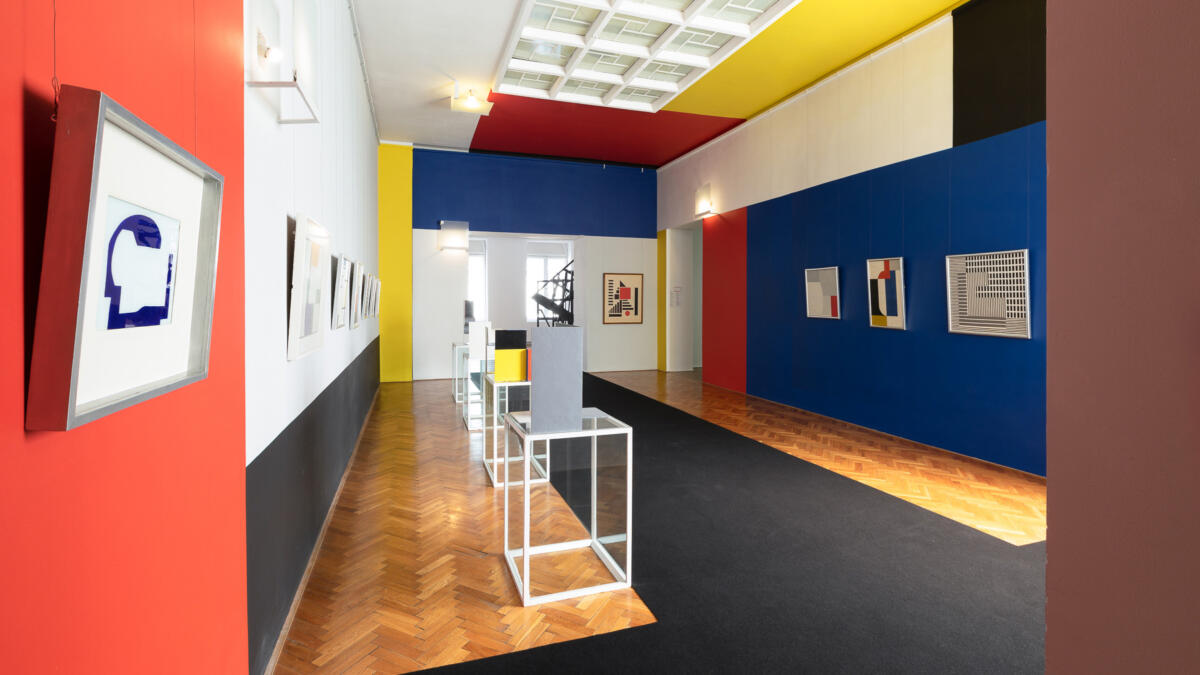
In the dominant narrative, the avant-garde and the museum are usually cast in the roles of mortal enemies, their encounter inevitably resulting in the failure of one or the other: the destruction of museums or the disarming of the avant-garde. This narrative could center on figures such as Edmond Duranty, a writer, columnist, and critic with much sympathy for the Barbizon painters and the Impressionists, who called for the Louvre to be burned down over 150 years ago, or the Futurist Marinetti, who half a century later argued that museums and libraries should be destroyed as repositories of anachronistic and unworldly cultural ideals. In the same narrative, the avant-garde is identified with living art, an art that wants to be consonant with the rhythm of the present, whereas museums are seen, to quote Adorno’s well-known phrase, as mausoleums, the family sepulchers where art withers away.[1] Or as mental asylums that “have wards and cells – in other words, neutral rooms called ‘galleries’.” “A work of art when placed in a gallery,” continues the author of the comparison, Robert Smithson,
“loses its charge […]. A vacant white room with lights is still a submission to the neutral. Works of art seen in such spaces seem to be going through a kind of aesthetic convalescence. They are looked upon as so many inanimate invalids, waiting for critics to pronounce them curable or incurable. The function of the warden-curator is to separate art from the rest of society. Next comes integration. Once the work of art is totally neutralized, ineffective, abstracted, safe, and politically lobotomized it is ready to be consumed by society.”[2]
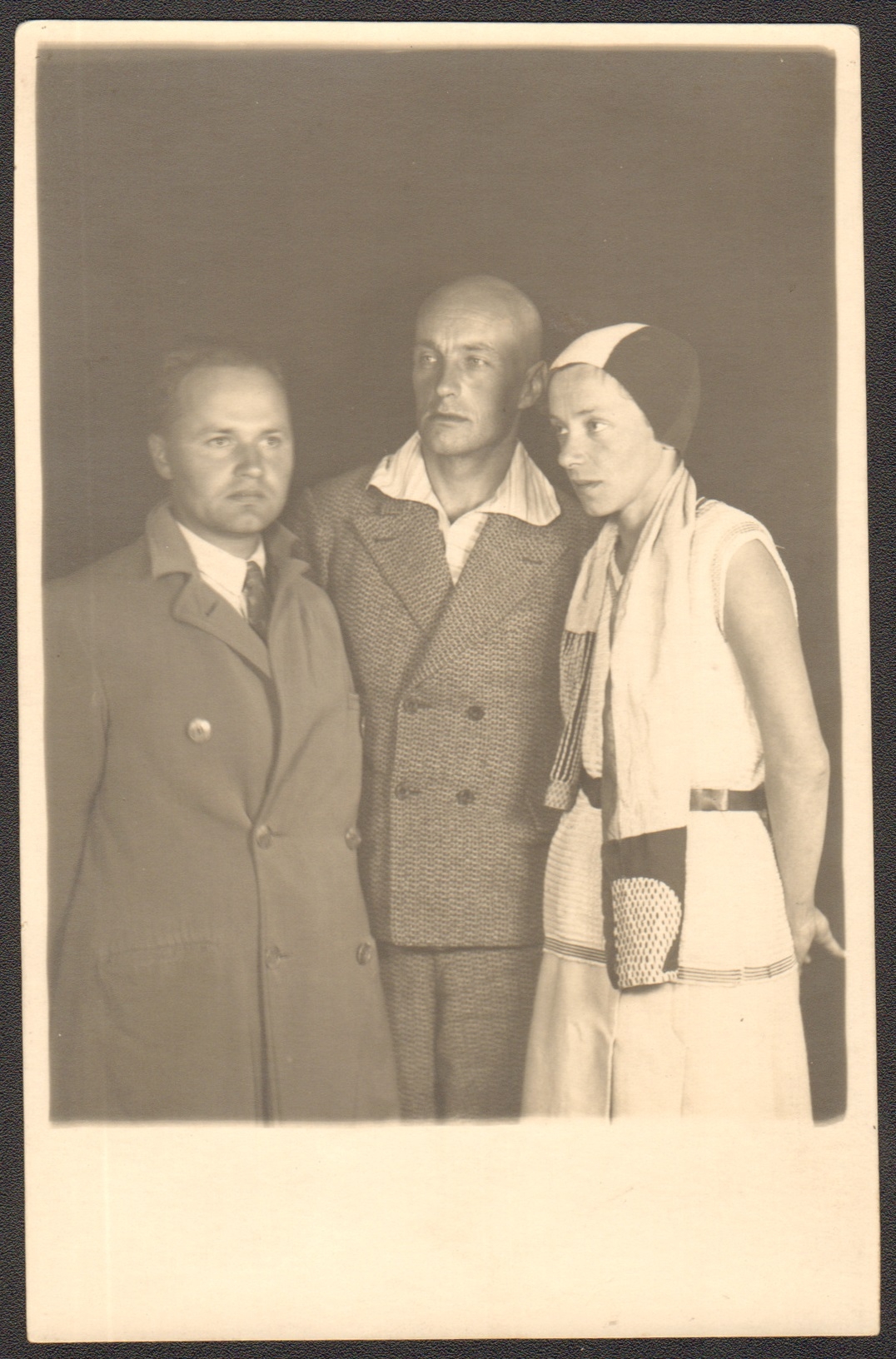
The members of the “a.r.” group (from left): Julian Przyboś, Władysław Strzemiński, Katarzyna Kobro, black-and-white photograph, ca. 1930-1931, the archive of Muzeum Sztuki in Łódź
On a theoretical plane, this opposition between the avant-garde and the museum was cemented by Peter Bürger and his influential 1973 book, The Theory of the Avant-Garde, which since its publication has influenced scholars and artists alike.[3] According to Bürger, at the heart of the avant-garde project is a promise to radically transform social life through art. This promise was meant to be realized not so much by introducing new, socially engaged content to art as by changing the role of art itself: instead of describing reality, art should seek to transform it. This mission entailed quitting the space in which art hitherto functioned and instead entering, and ultimately becoming fully integrated with, the practice of everyday life. The fact that the space of art had not been abandoned was, according to Bürger, proof that the avant-garde project had failed. That avant-garde creations ended up in museums had reduced them to the role of “art works,” of the same status as their historical predecessors, while they were intended to be means of a global revolution, one that was existential rather than artistic. Museums, therefore, along with the entire art world-constituting system, are responsible for disarming the avant-garde.
But there is another story besides the one presented above, one where there are neither calls for museums to be burned down, nor suggestive images of art being lobotomized by museum curators. Instead, there are artists making an effort to develop their own museum institutions as what they believe can be effective means of achieving avant-garde goals. Most intriguingly, these are artists associated with Dadaism and Constructivism, i.e. the most radical factions of the avant-garde movement, which, according to Bürger, strove most vigorously to dismantle the institution of art. This story brings together Soviet radicals establishing a museum network meant to cover the whole Republic, a Russian Constructivist designing a cabinet of abstractions at a Hanover museum, and uncompromising European and American modernists trying to start the first museum of modern art in New York. The creation by the “a.r.” group of the International Collection of Modern Art at the Łódź municipal museum, today known as Muzeum Sztuki, belongs to this story too.

The permanent exhibition of the International Collection of Modern Art of the “a.r.” group at the J. and K. Bartoszewicz Municipal Museum of History and Art in Łódź, photo: Włodzimierz Pfeiffer, 1932, the archive of Muzeum Sztuki in Łódź
Museums of Artistic Culture
The beginnings of avant-garde museology date back to the stormy times of the October Revolution, and are bound up with efforts to effect an institutional reform of Russia’s cultural life. Discussions on the desired course of such a reform involved the leading representatives of the Russian avant-garde, including Vassily Kandinsky, Kazimir Malevich, Vladimir Tatlin, and Alexander Rodchenko. It was within this community that the idea was conceived of establishing a network of institutions to foster and disseminate modern art, which eventually came to be known as “museums of artistic culture.”[4] The first conception of this new type of museum was presented in 1918 by Tatlin and Sophia Dymshits-Tolstaya, who envisaged it as a large-scale complex, with exhibition galleries accompanied by lecture rooms, artists’ studios, and laboratories for testing new painting technologies and conducting experiments with new artistic forms.[5] In the course of further heated debates—the culmination of which was a museological conference organized in Petrograd in February 1919 by the IZO-Narkompros [Department of Fine Arts of the People’s Commissariat for Education]— it was agreed that the institution’s mission would be to collect, study, and popularize works of “artistic culture,” that is, inventive creative production that would stimulate and give direction to the further development of art.[6] Art of the past periods was to be removed from the museum galleries and replaced by art of the present day. “Our contemporary life,” Malevich declared,
“needs only living and life-giving energy, it needs flying iron beams and colored signals along the new path. It is essential that creative work be built on these foundations, burning the path behind it […]. Setting up a contemporary museum means collecting contemporaries’ projects and nothing more; only those projects which can be adapted to, or which will lead to new forms of the skeleton of life, can be preserved for a time.”[7]
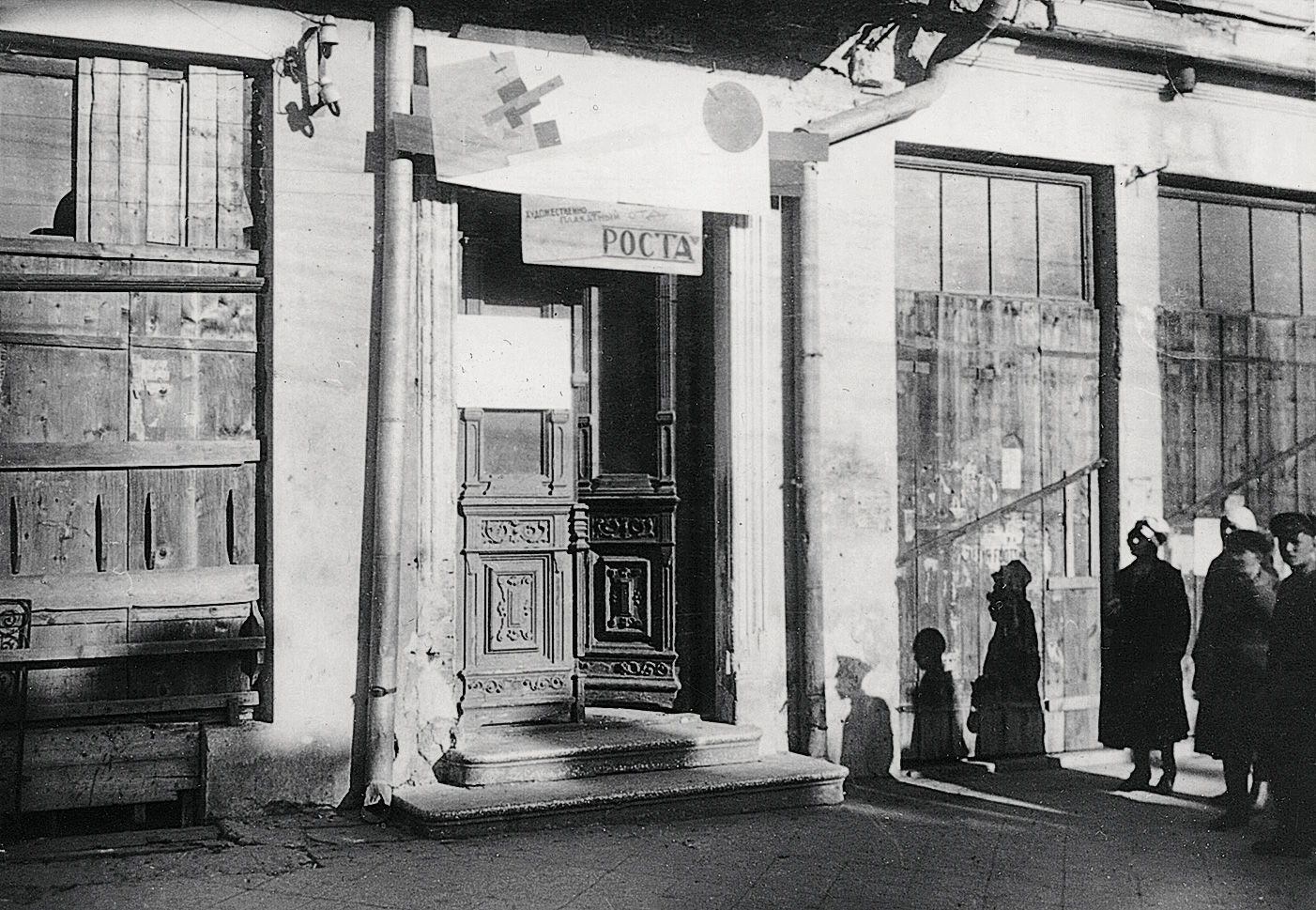
A suprematist mural above the door to the ROSTA office, probably in Smolensk, on the building at Bolszaja Sovetskaya Street, where Strzemiński and Kobro ran the Art Studio and where the UNOVIS branch was located, ca. 1920, photo: ‘The Encyclopedia of the Russian Avant-garde’, 2013–2014
Spreading “creative models” around the country, such museums would “stimulate the transformation of forms into life, and artistic visions into industry.”[8] Importantly, it was artists who would have decisive say in them. As the declaration adopted during the Petrograd conference proclaimed,
“Characteristically, the museologist strives to preserve everything that the artist has created, while the artist strives to create something new. Since the artist is the creative force in the field of art, one of their goals is to be responsible for the country’s artistic education. It is impossible for museologists […] to be sufficiently competent as far as artistic production and education are concerned.”[9]
For the same reason, “the acquisition of contemporary works of art should be the sole domain of artists.”[10]
Initially, the main theoretician of the first institution of this kind, founded in 1919 in Moscow, was Kandinsky, who intended, through its collection, to present a history of painting seen as a process of formal evolution, governed by its own inner logic.[11] The museum exhibition would demonstrate the development of purely artistic forms—“of all time-periods and nations”—with the purpose of demonstrating the avant-garde’s historical pedigree and thus securing broad public legitimacy for its current experiments.[12] Kandinsky’s concept met with some criticism within the art community, and ultimately both the Moscow museum and those set up elsewhere as part of the network would be restricted to collecting the works of living artists. This was in keeping with a policy advocated by Rodchenko, who considered the museum not as an “archive” of works of solely historical value, whose potential to influence has already been exhausted, but rather as a reservoir of “living forms,” still capable of helping to transform the world.[13] The new institution was conceived as a Museum of Experimental Techniques, and its mission, as Rodchenko’s partner in art and private life, Varvara Stepanova, wrote, should include initiating “new explorations for future media for art.”[14] Instead of illustrating art history, museums were meant to serve as laboratories of innovation, and their collections as repositories of forms, techniques, and methods that could be used by artists for further development of art, but also by technologists and engineers seeking inspiration for practical solutions to better organize the human environment.[15] To emphasize this technological perspective, works would be organized by their contribution to the development of artistic methods and media rather than by chronology or individual authorship.[16]
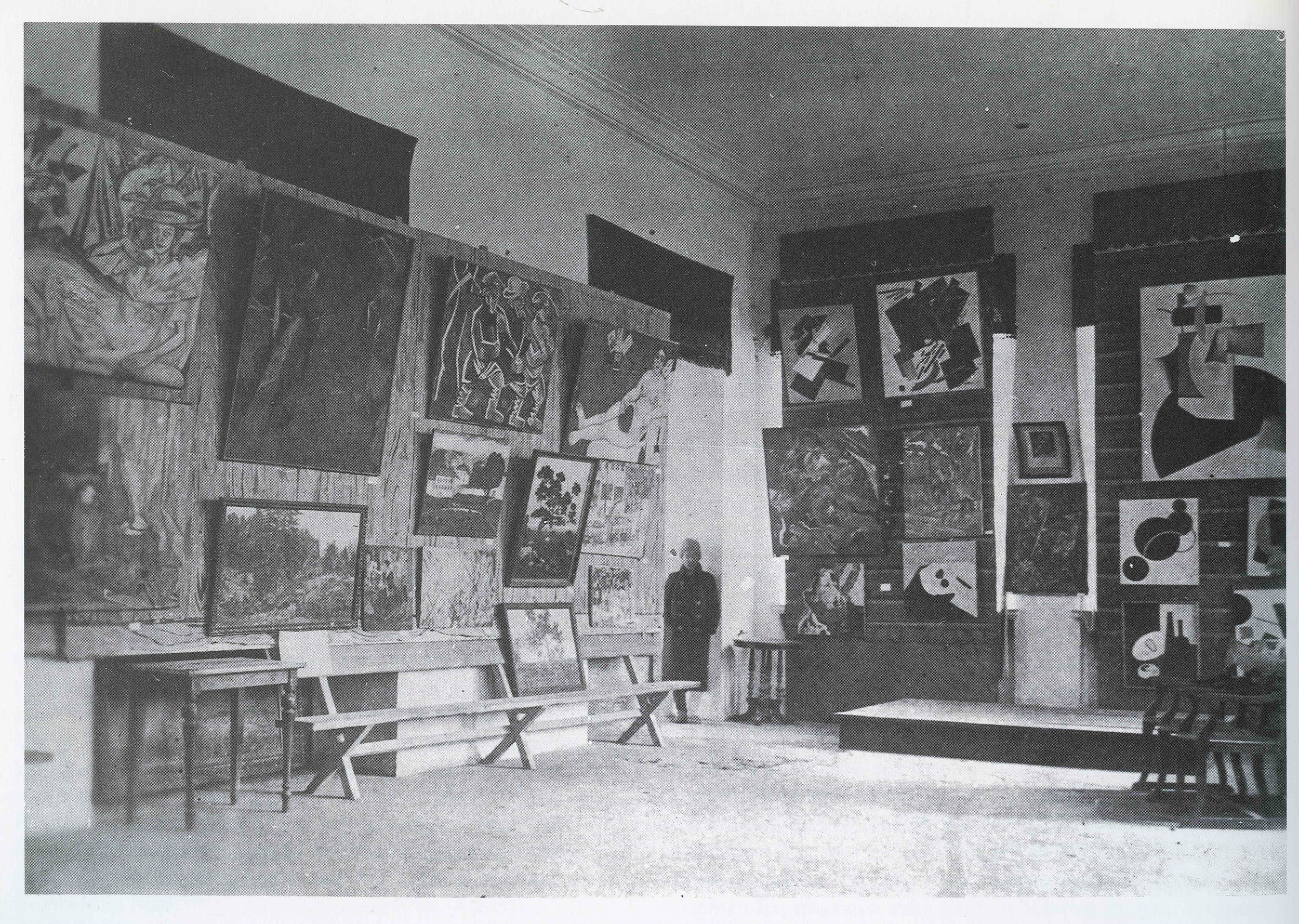
Fragment of the collection at the IZO-Narkompros museum office, late 1919, artworks by Malevich, Goncharova, Larionov, Kandinsky, Rodchenko and others, photo: ‘The Encyclopedia of the Russian Avant-garde’, 2013–2014
The reflections accompanying the development of the formula of museums of artistic culture were focused not only on what they should preserve and what their narrative should be, but also on viewer experience. Consequently, high importance was attached to exhibition design. Malevich believed that the entrenched practice of exhibiting art according to schools, trends, or periods weakened the power of individual works. Instead, he proposed to arrange the works on the wall “in the same way the composition of forms is arranged on the surface of the painting.”[17] Contemporary art exhibitions should be designed so as to promote a critical attitude towards imitative, derivative art, and thus to lay the foundations for the universal acceptance of artistic culture.[18] Rodchenko also rejected the traditional exhibition model and the reception paradigm bound up in it, based on passive contemplation meant to provide purely sensual pleasure. He also spoke against perceiving the work of art as a decorative “complement” of the wall. Instead, as he wrote, the work should become an “active agent.”[19] Art works would be arranged in the museum gallery in such a way so as to stimulate the spectator’s activity and encourage them to intellectually reconstruct the processes that have led to recent artistic innovations. The aesthetic experience was identified with what Stepanova called “active thinking” and “laboratory work.”[20] From a site of sophisticated entertainment, the museum was turning into a work place, where, as Maria Gough put it, the revolutionary subject’s perception was being activated.[21]
The museums of artistic culture proved short-lived; moreover, cases where initial plans yielded actual institutions, properly staffed with a permanent space, were few and far between.[22] Usually, those were entities that never went beyond a provisional stage. The process of phasing them out began after just a few years as the official Soviet cultural policy changed[23] and the leading forces of the Russian avant-garde became radicalized, moving on to positions of productivism and agitprop and calling into question the rationale of making—and therefore collecting and popularizing—art that was devoid of immediate practical value.[24] The Moscow museum was ultimately incorporated by the Tretyakov Gallery in 1928; the other ones had discontinued operations even before that.[25]
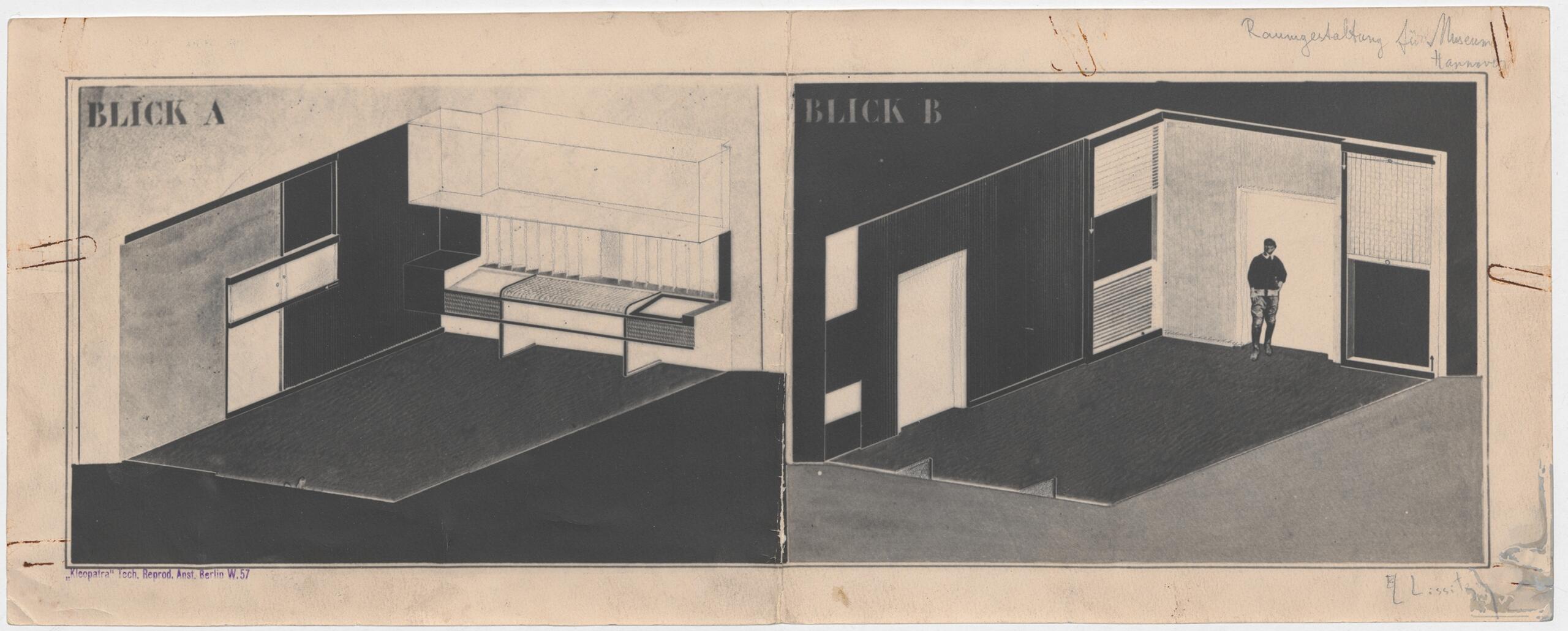
El Lissitzky (1890–1941), ‘Kabinett der Abstrakten’, Provinzialmuseum Hannover, 1927, Sprengel Museum Hannover, photo © bpk/BE&W
Kabinett der Abstrakten
Though brief, the episode of the museums of artistic culture proved influential enough to inspire other museological projects. One of those was the Kabinett der Abstrakten, designed by El Lissitzky and installed in 1927–28 as part of a new permanent exhibition at the Provinzialmuseum Hannover.[26] The latter’s then director, Alexander Dorner, had styled the exhibition as a series of Atmosphärenräume, where the color of the walls, lighting, the arrangement of the works, and other discreet design gestures were meant to evoke the mood of successive artistic periods.[27] Dorner believed that the museum should educate its public not so much through texts, descriptions, and captions providing ready-made information as by creating a proper setting where the profound essence of the different historical periods could be experienced in an emotional and sensual way. Faithfully illustrating the stylistic changes that material culture had undergone was less important here than demonstrating how the human experience of being in space and time—and the understanding of those realities—had evolved over time.[28] Following such a museum narrative, the spectators would gain a fuller awareness of their place in the world.[29]
In the story narrated at the Provinzialmuseum Hannover, Lissitzky’s cabinet was tasked with visualizing the spatiotemporal dimensions being discovered by abstract art.[30] Among other artists, it showed the works of Piet Mondrian, László Moholy-Nagy, Pablo Picasso, Fernand Léger, Mies van der Rohe, Kurt Schwitters, Alexander Archipenko, and Lissitzky himself, and the architecture was supposed to realize—and help the spectator experience—the new spatiotemporality explored by avant-garde works.[31] The Kabinett was lined with narrow vertical metal slats painted so that, depending on the spectator’s position, the walls appeared black, white, or more or less intensely gray. Moreover, some of the paintings were displayed in cassettes behind covering plates that the spectator could slide right or left, up, or down, revealing or obscuring a part or the whole of the given art work. Such solutions, Dorner believed, allowed the spectator to experience the fluid, indeterminate, and multidimensional qualities of space of abstraction–thus elucidating the meaning of this kind of art.[32]
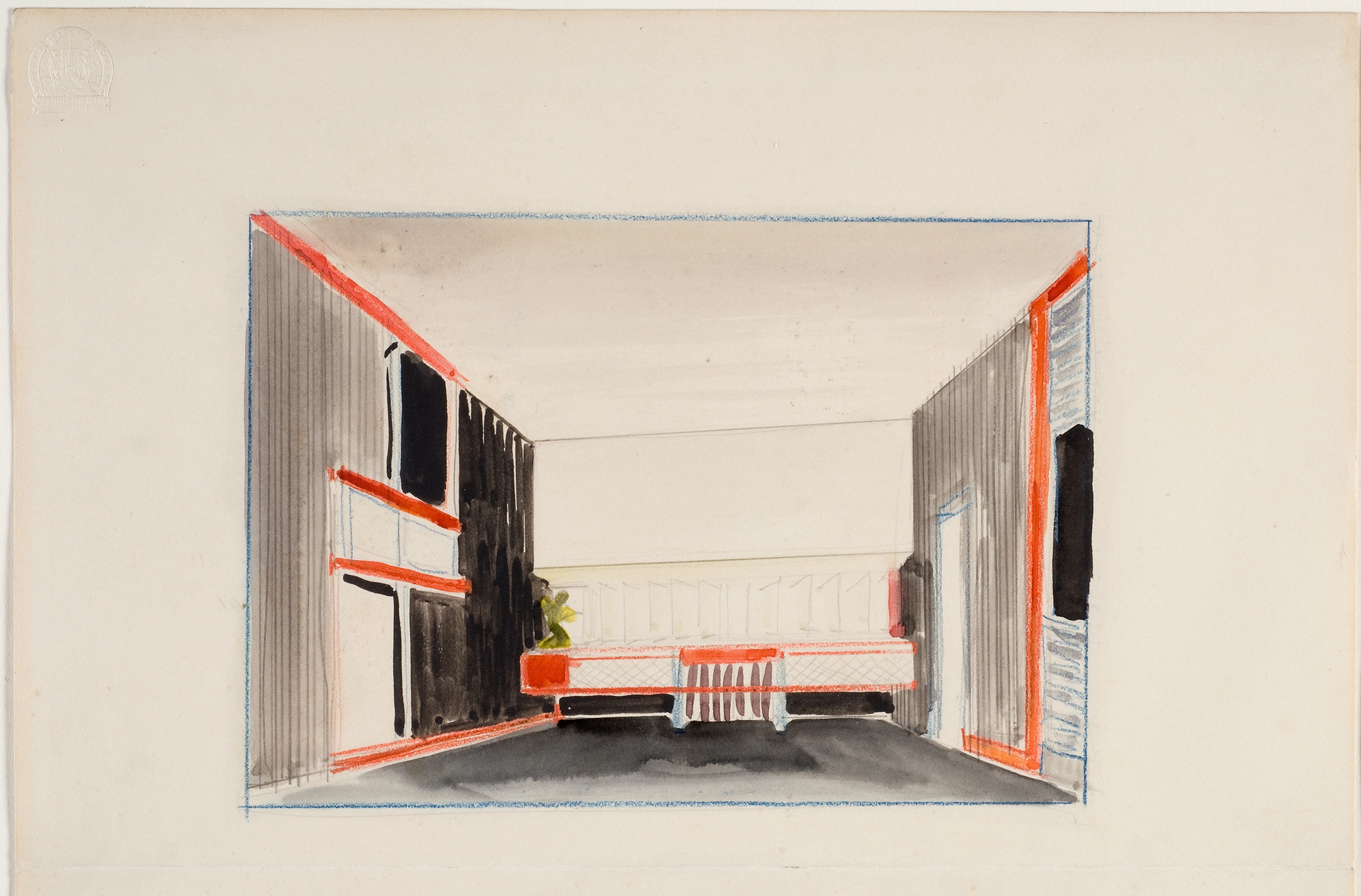
El Lissitzky (1890–1941), ‘Kabinett der Abstrakten’, sketch, 1926–1927, watercolor, colored crayon and pencil on paper board, 33 x 42 cm, Sprengel Museum Hannover
Although the Kabinett der Abstrakten had a precisely defined role to play in Dorner’s museological project, it was primarily a continuation of El Lissitzky’s previous experiments, derived from his own preoccupation with avant-garde exhibition design.[33] The technological and formal solutions employed in the cabinet—the color-changing wall slats, the moving cover plates—were transferred directly from the Raum für konstruktive Kunst, which Lissitzky designed for the Internationale Kunstausstellung in Dresden in 1925.[34] On the conceptual level, in turn, the cabinet built on the ideas contained in the Prouns, a series of works conceived as an artistic analogon of the space models constructed by modern science.[35] Being interested in non-Euclidean geometries and relativity theory, Lissitzky sought—first with painterly means, and then with architectural solutions—to create an environment that would let the spectator experience and comprehend the conventional character of what is perceived as real space, but is merely a naturalization of customary ways of imagining it.[36] In the PROUN Manifesto, he stated, “If futurism put the spectator inside the canvas, we take him via the canvas into real space; we put him in the centre of a new construction of distance.”[37] The Dresden and Hanover projects were a culmination of those experiments, being examples of “imaginary space,” such that, rather than existing objectively, is only temporarily actualized in the spectator’s mind as a result of his psychophysical activity aroused by proper visual stimuli (lighting, texture, color combinations, composition of forms).[38] In this space, human thought frees itself of the limitations imposed by the three-dimensional world, perceptive capabilities expand, and creativity is heightened.[39]
The Raum für konstruktive Kunst and the Kabinett der Abstrakten thus become a model environment for a more profound reception of contemporary art.[40] Lissitzky noted,
“Large international art shows resemble a zoo where the visitors are subjected to the roar of thousands of assorted beasts. My space will be designed in such a way that the objects will not assault the visitor all at once. While passing along the picture-studded walls of the conventional art exhibition setup, the viewer is lulled into a numb state of passivity. It is our intention to make man active by means of design. This is the purpose of space.”[41]
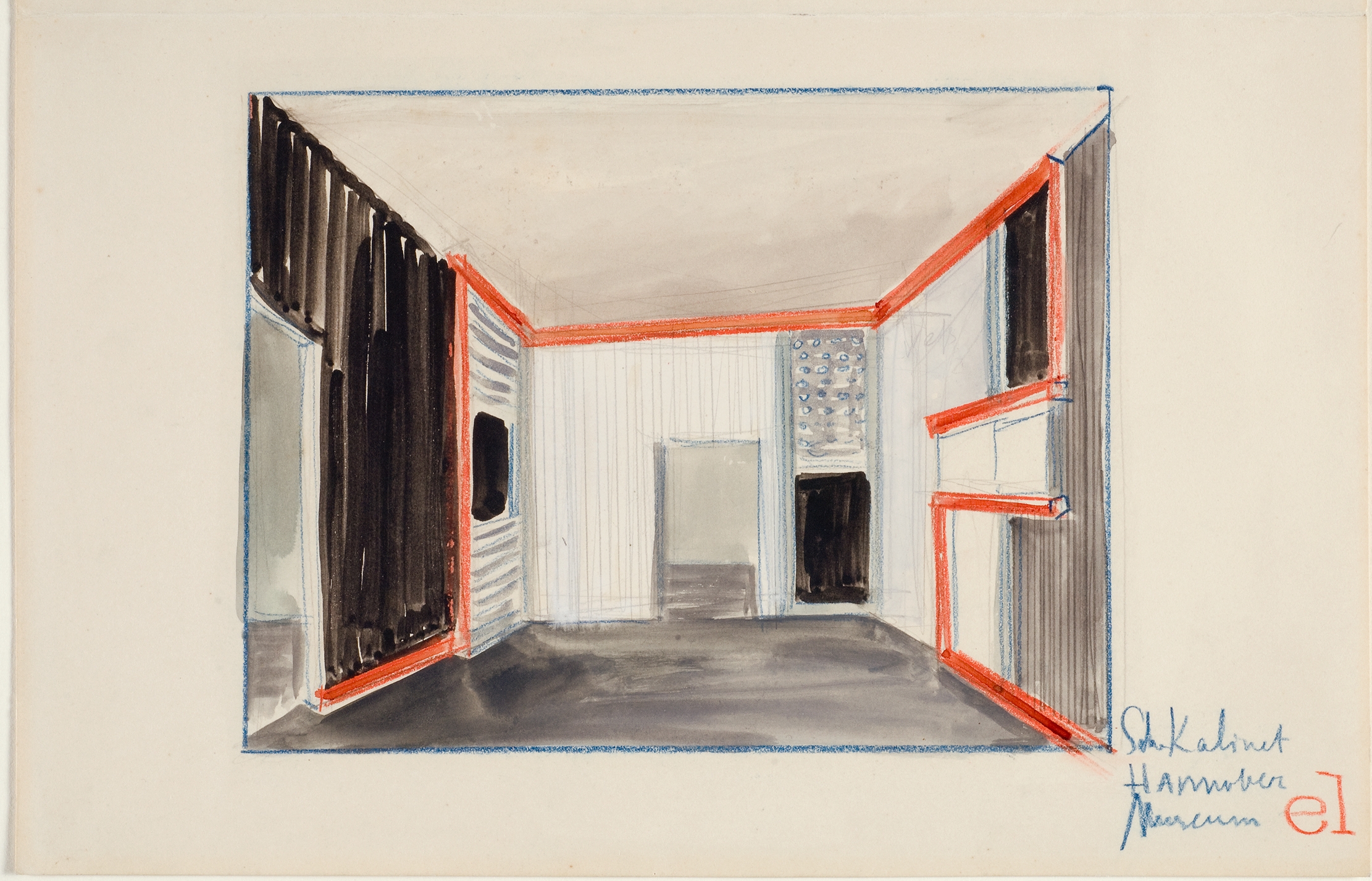
El Lissitzky (1890–1941), ‘Kabinett der Abstrakten’, sketch, 1926–1927, watercolor, colored crayon and pencil on paper board, 33 x 42 cm, Sprengel Museum Hannover
Therefore, the exhibition designer faces two interrelated tasks. The first is to create a situation whereby each of the works has a chance to capture the spectator’s attention:[42] “To achieve an equivalence of effect for all works,” Lissitzky writes, “an optimum optical environment has to be created for such an exhibition space, similar to optimal acoustic conditions necessary for a concert hall.”[43] The second task is to orchestrate the viewer’s experience, to rouse him from passivity and provoke him to adopt a position towards the works on show.[44] Indeed, the work is actualized solely through the activity of the spectator, who, in a sense, has to become its co-author.
In view of the way it treats the walls not as neutral display surfaces but as a construction that heightens the works’ effect and organizes perception and of its rejection of passive contemplation as a reception model, the Kabinett der Abstrakten can be considered a realization of the postulates that emerged in the course of the debate on the museums of artistic culture.[45] The need to “activate” exhibits through proper exhibition design was mentioned by both Malevich and Rodchenko; the latter also stressed the need to engage with the spectator and make them become involved. According to the intended assumptions of the museums of artistic culture, the museum exhibition was to become a space of independent, analytical work, or, as Stepanova would have called it, a site of “experimental cognition.”[46] Lissitzky went even farther in that direction: the way the space changed its appearance with the spectator’s every move and the possibility of covering and uncovering the works meant that the viewer, on the one hand, lost their stable vantage point and, on the other, gained agency in modeling what they saw. Their task was no longer just to try and reconstruct the artist’s cognitive process, but to realize that all cognition was relative and to start their own independent cognitive activity.[47] This seems to have been the ultimate goal of Lissitzky’s exhibition-design experiments aimed at establishing a new paradigm in the socialization of artistic production.
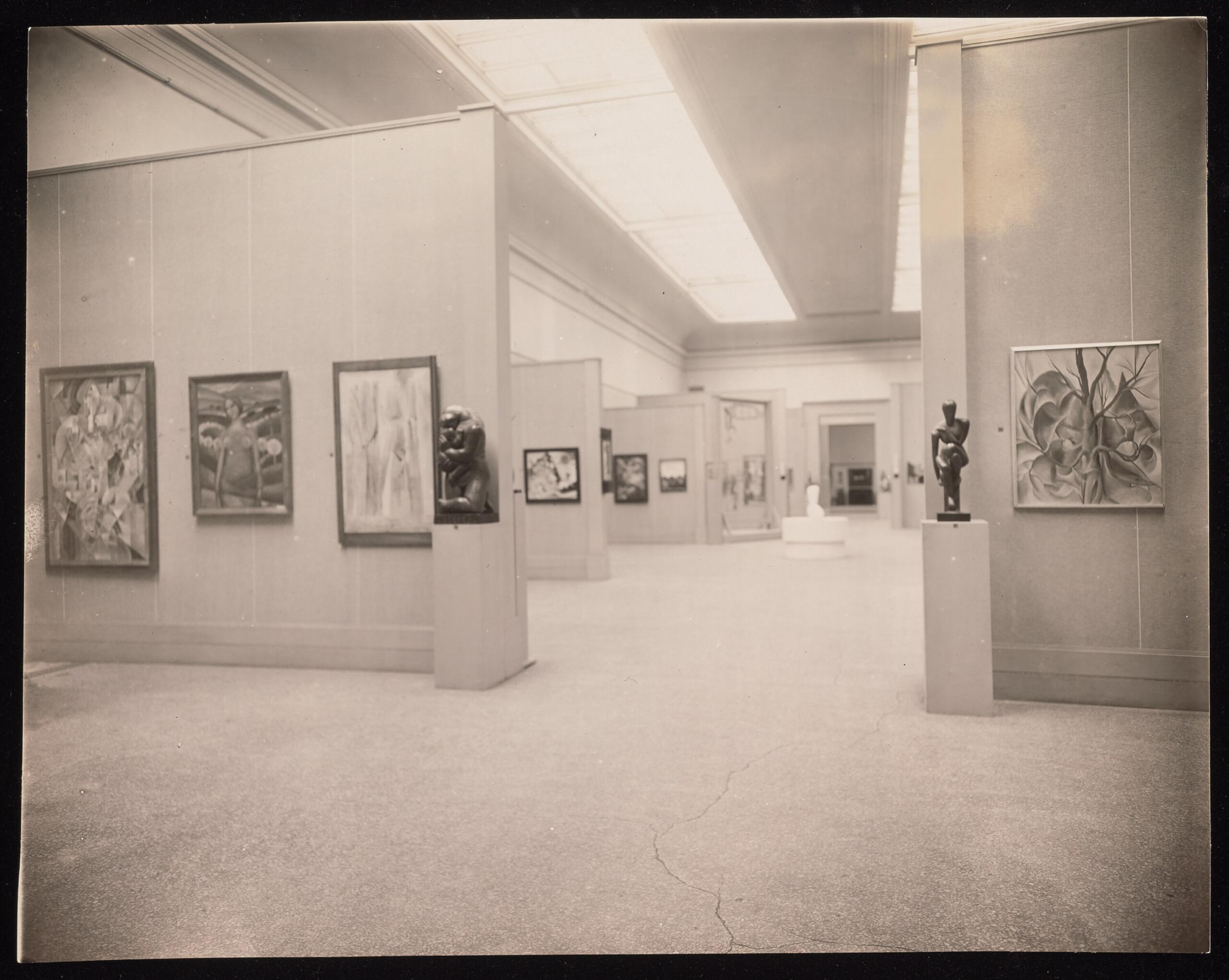
The view of the main hall of International Exhibition of Modern Art arranged by Société Anonyme, the Brooklyn Museum, 1926, Katherine S. Dreier Papers / Société Anonyme Archive, Yale Collection of American Literature, Beinecke Rare Book and Manuscript Library, Yale University
The Société Anonyme: The Museum of Modern Art 1920
Almost concurrently with the initiatives launched by Soviet avant-garde, a museum project was emerging in New York, championed by two leading figures of European and American dadaism, Marcel Duchamp and Man Ray. That project was the Société Anonyme, an organization founded in New York in 1920 for the purpose of promoting modern art.[48] Its main driving force was Katherine S. Dreier, daughter of a wealthy industrialist and civil activist, and at the same time, a talented painter, participating, for example, in the famous Armory Show in New York in 1913.[49] From the outset, she envisaged the Société and the gallery it initially ran as a museum, writing its name in documents and publications with the tag-line “Museum of Modern Art.”[50] It was meant to work with experts, collectors, and critics, but it was artists, as in the museums of artistic culture, that would have the final say.[51] Besides Dreier, Duchamp, and Ray, the Société’s board of directors also included, at various periods, Kandinsky, Joseph Stella, Marsden Hartley, Heinrich Campendonk, and Naum Gabo.[52]
The reasons for founding the organization were explained by Duchamp years later in a telegram sent to Dreier:
“ALREADY 1920 NEED FOR SHOWING MODERN ART STILL IN CHAOTIC STATE OF DADA IN NON-COMMERCIAL SETTING TO HELP PEOPLE GRASP INTRINSIC SIGNIFICANCE STOP AIM OF SA TO SHOW INTERNATIONAL ASPECT BY CHOOSING IMPORTANT MEN FROM EVERY COUNTRY UNKNOWN HERE SCHWITTERS MONDRIAN KANDINSKY VILLON MIRO. DUCHAMP 1920 DADA SA.”[53]

Katherine S. Dreier (1877–1952), ‘Two worlds’, 1930, oil paints, canvas, 71,8 x 91,7 cm, Yale University Art Gallery, gift of Collection Société Anonyme
In catalogs, press releases, and official correspondence, it was repeatedly stressed that the “aim of the Societé Anonyme is educational. It is an international organization for the promotion of the study of the experimental in art, for students in America and renders aid to conserve the vigor and vitality of the new expression of beauty in the art of today.”[54] The Société’s work was meant to overcome the aversion the American public felt towards modern art, an aversion that, it was suggested, stemmed from spiritual backwardness, consumerist materialism, and a parochial hostility toward anything unfamiliar.[55] Dreier believed that contact with modern art, “which is an international language,” contributes to a “better understanding of the nations”[56] and to an opening up to the onset of a “new era” of humanity, heralded by its universalism, when all national and cultural divisions are erased.[57] Through the work of progressive artists, contemporary societies were to connect with their spiritual essence, their “love of power and speed,” a “desire to cover distances as expressed through electricity and the wireless vibrations of the air,” which attests to a need for a “coming together of all the peoples of the world,” meaning a “greater brotherhood of man or greater slavery.”[58]
Besides staging exhibitions—first at its own space and later increasingly at third-party galleries, museums, clubs, and educational centers—the Société Anonyme organized lectures, debates, and concerts, and published books that popularized modern tendencies in the arts.[59] However, what remains the most lasting and spectacular effect of its activities is its collection, which, by the late 1930s, had grown to over 600 works, both by leading representatives of the international avant-garde (e.g. Brâncuşi, Mondrian, Kandinsky, Picasso, Lissitzky, Malevich, Léger, Braque, Ernst) and by artists virtually unknown outside their local communities (including Polish ones: Alicja Halicka, Gustaw Gwozdecki, and Louis Marcoussis). In the selection process, the artist’s market value, affiliation with this or that movement, or nationality did not matter. Instead, Duchamp and Dreier, who mainly made the choices, followed their intuition, informed by their own artistic experience and their personal sense of the significance of the given artist. What counted above all was innovation—Dreier liked to quote John Ruskin’s “Invent or perish”[60]—and an ability to express the zeitgeist.[61] The result was a collection of extraordinary breadth in terms of style, artistic ideologies represented, and the artists’ nationalities. It suggested that what mattered the most was the artist’s individuality, ignoring national and stylistic divisions and connecting with other creative individuals in a “cosmic” spiritual community beyond all borders.[62] While the existence of local differences was not denied, their significance was downplayed; Dreier called them a “dress” concealing a unity of human strivings.[63]

A catalogue published on the occasion of International Exhibition of Modern Art arranged by Société Anonyme in the Brooklyn Museum, graphic design: Katherine S. Dreier and Constantin Alajalov, Société Anonyme, New York, 1926, Katherine S. Dreier Papers / Société Anonyme Archive, Yale Collection of American Literature, Beinecke, Rare Book and Manuscript Library, Yale University
This notion of modern art also found its reflection in the design of Société Anonyme exhibitions. The largest and most famous of those, the International Exhibition of Modern Art, staged at the Brooklyn Museum at the turn of 1926–27, could initially create the impression of a chaotic compilation. The works did not seem to be arranged by any affinities whatsoever, whether stylistic, chronological, or genealogical; instead, the show was composed using an associative method and conceived, according to Dreier, as “one big painting,” where elements of different origins combine to produce a whole of a higher order—the emanation of a universal spirit of modernity.[64] The way the paintings were hung in a single line, evenly spaced apart, with none emphasized more than others, made it clear that this spirit manifested itself in the work of established artists as much as in that of lesser-known ones.[65] The design of the catalog, where the works’ authors were listed by country of origin, further suggested that modern art was being born everywhere, from Japan to Russia and from Canada to Spain.[66] Moreover, for the show’s second edition a few months later at the Anderson Galleries, a solution was employed that invested modern art with historical depth. This was Frederick Kiesler’s “television room”—a dark room with a projector where, as Dreier described it years later, “in turning a button the Mona Lisa from the Louvre would appear, or if pressed again, Velasquez’s Venus from London, or a Rembrandt from the Rijks Museum would be lighted.”[67] These references to the masterpieces of the past were not meant to construct a pedigree for modern art or prove that it was an inevitable consequence of historical/artistic development. Rather, they served to point out that “art belongs to the creative functions of man,” and as such it “express itself in [the form], depends upon the century in which it makes its appearance,” which is why contemporary artists, like their great predecessors, had the right to seek forms suitable for their era.[68]
In line with the Societé Anonyme’s democratic beliefs and social mission, this educational message was to be directed at the general public, not just the sophisticated museum-goers, consisting mostly of members of the financial and cultural elite. “It is very important,” wrote Dreier in a letter, “that art should be brought to all classes and that we should develop in our country a genuine love which does not end in attending lectures, but ends in the desire to own pictures. If they could develop in our people the need to own paintings, with which they could live constantly, it would be a great step forward.”[69] In order to demonstrate how art could become an element of daily life, Dreier arranged several small exhibition spaces within the Brooklyn museum’s exhibition as typical middle-class interiors. Paintings and sketches by Lissitzky, Halicka, Arp, Schwitters, and other modern artists were juxtaposed with eclectic furniture pieces from the popular Abraham & Straus department store.[70] This, according to Dreier, was how to erase the division between art and life, as she postulated that “art and life must become interchangeable terms” and that “we can never rise to be a great people until we bring art back as an inherent part of life.”[71] Unlike in the Russian avant-garde, which derived from it a plan for a total transformation of the world according to artists’ ideas, here the proposition was translated into a project much more modest and pragmatic: to ensure the presence of modern art in the average American home. The difference reflected two notions of art: as a collective revolutionary act and as an individual emancipatory experience.
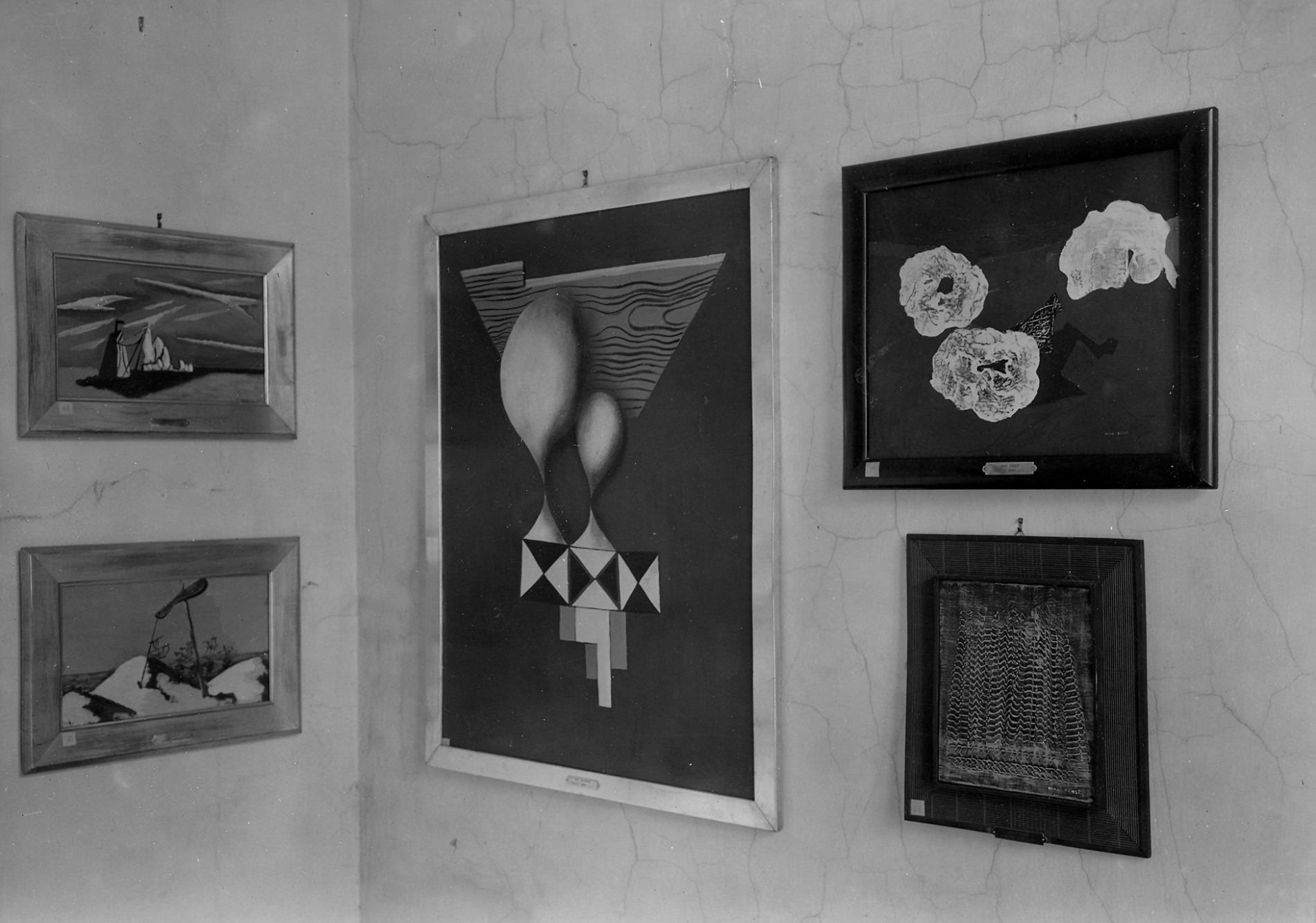
The exhibition at the J. and K. Bartoszewicz Municipal Museum of History and Art in Łódź, the 1930s, the archive of Muzeum Sztuki in Łódź
The “a.r.” Group’s International Collection of Modern Art
Among the avant-garde institutions discussed in this essay, the “a.r.” group’s International Collection of Modern Art was the last to be started, yet it has proved the longest-lasting. As we have mentioned, the museums of artistic culture functioned for only a couple of years, El Lissitzky’s cabinet was liquidated by the Nazis in 1937,[72] and the Société Anonyme was officially disbanded in 1950, though works from its collection started being donated to the Yale University Art Gallery from as early as 1941.[73] Only the a.r. collection became the catalyst for an institutional process that resulted in the establishment of a museum whose identity remains determined by avant-garde ideas to this day.[74]
Władysław Strzemiński, a leading representative of Eastern European Constructivism, and at the same time the spiritus movens behind a number of the Polish avant-garde’s key projects, was the originator of the a.r. collection. Together with Katarzyna Kobro, his later wife, but above all a great avant-garde sculptor, he began his artistic career in post-revolutionary Moscow, alongside Tatlin, Rodchenko, Lissitzky, and Malevich, among others. Working in this community, and performing administrative functions in arts promotion and exhibition, he participated in the debates on the museums of artistic culture. Among his other capacities, Strzemiński served as head of the Central Bureau of Artistic Exhibitions in Moscow, and later, having moved to Smolensk, co-organized an exhibition at the municipal gallery there.[75] Inspired by the Russian experience, he started efforts to establish a modern art museum in Poland, which he achieved with Kobro at the turn of 1921–22. At first, he thought of locating it in Warsaw and tried to garner interest for the idea among members of the avant-garde Blok collective (1924–26), later Praesens (1926–29).[76] The response, however, was lukewarm: some believed the museum was an institution too closely connected with the traditional model of art and its distribution, while others were more interested in combining art with architecture and other utilitarian forms than creating institutional enclaves for it.[77]
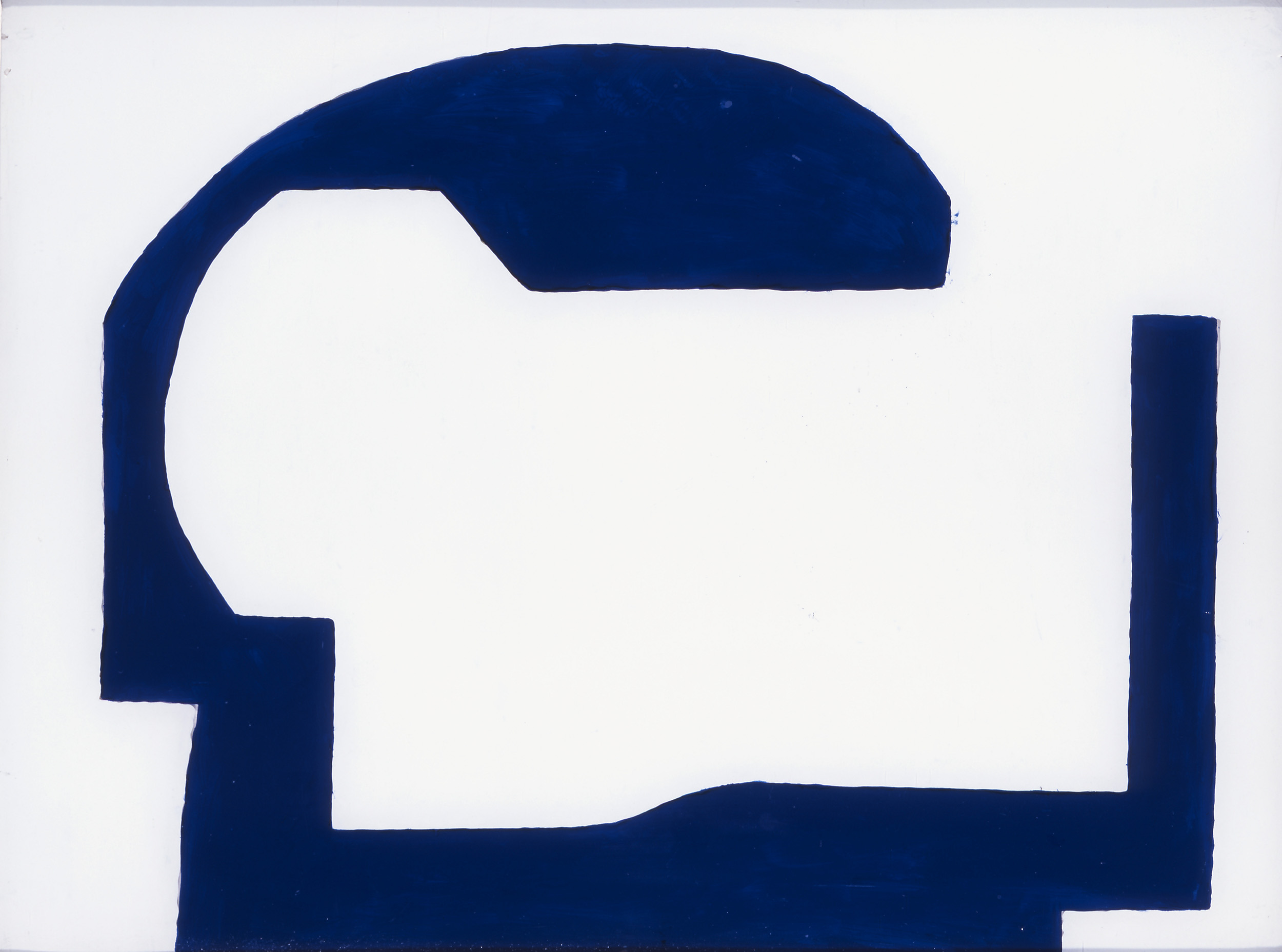
Katarzyna Kobro, ‘Abstract Composition’, 1924-1926, oil paints, glass, 24 × 32 cm, Muzeum Sztuki, Łódź, © Ewa Sapka Pawliczak and Muzeum Sztuki in Łódź
Favorable conditions emerged only in the late 1920s, and not in Warsaw, but in Łódź, a rapidly developing city with modest cultural traditions, known, above all, as one of Poland’s largest industrial hubs. The city had for some time been governed by the socialists, who initiated a series of educational and cultural projects aimed at bolstering the cultural competences and the intellectual/spiritual development of its citizens, notably the working masses. One of those projects was a municipal museum, created on the basis of a collection donated by Krakow historians and antiquarians Janusz Bartoszewicz and Kazimierz Bartoszewicz. This collection consisted of historically significant archival materials, valuable incunabula, and art works, mainly Polish paintings from the second half of the nineteenth century, and it can be safely assumed that a museum created on its basis would have resembled dozens of other provincial institutions of its kind. Yet this case was to be different, because of Strzemiński’s idea to create and house a permanent collection of modern art there. The city hall was sympathetic to the idea, and so encouraged, Strzemiński started efforts to acquire works for the collection-to-be. These efforts become one of the main activities of the a.r. group, which Strzemiński founded in late 1929 with Kobro, the Constructivist painter Henryk Stażewski, and two avant-garde poets: Julian Przyboś and Jan Brzękowski.
Having moved from Soviet Russia, Strzemiński and Kobro never left Poland again; however, they maintained lively correspondence with leading members of the European avant-garde: Strzemiński wrote with Mondrian, Arp, Marinetti, Malevich, and van Doesburg, among others, and featured their articles and reproductions of their works in the periodicals he co-edited. Both Strzemiński and Kobro published in international art magazines, and their works had been presented in several major international exhibitions. They were not unknown figures, and their art enjoyed recognition among radical avant-gardists, which meant that the initiative met with a strong response in the European art world. Others who helped to build an international coalition of support were Stażewski, associated with the avant-garde collectives Cercle et Carré and Abstraction-Création, and Brzękowski, who, with Wanda Chodasiewicz-Grabowska (the later Nadia Legér) published the bilingual periodical L’Art Contemporain—Sztuka Współczesna, a forum for a cosmopolitan community of Paris-based poets and artists.[78] Through their efforts, supported personally by Arp and Michel Seuphor, a.r. received—and as donations, no less— works from artists such as Arp himself, Picasso, Legér, Schwitters, Alexander Calder, Sonia Delaunay, Max Ernst, Vilmos Huszár, Amédée Ozenfant, Enrico Prampolini, Sophia Taeuber-Arp, Joaquin Torres-Garcia, and Georges Vantongerloo. In all, between 1929 and 1939, a total of 112 works were added to the collection, representing all the significant trends of the European avant-garde, including an extensive representations of both geometric and non-geometric abstraction in various forms. The permanent exhibition of the a.r. International Collection of Modern Art at the Łódź museum was inaugurated on 15 February 1931.
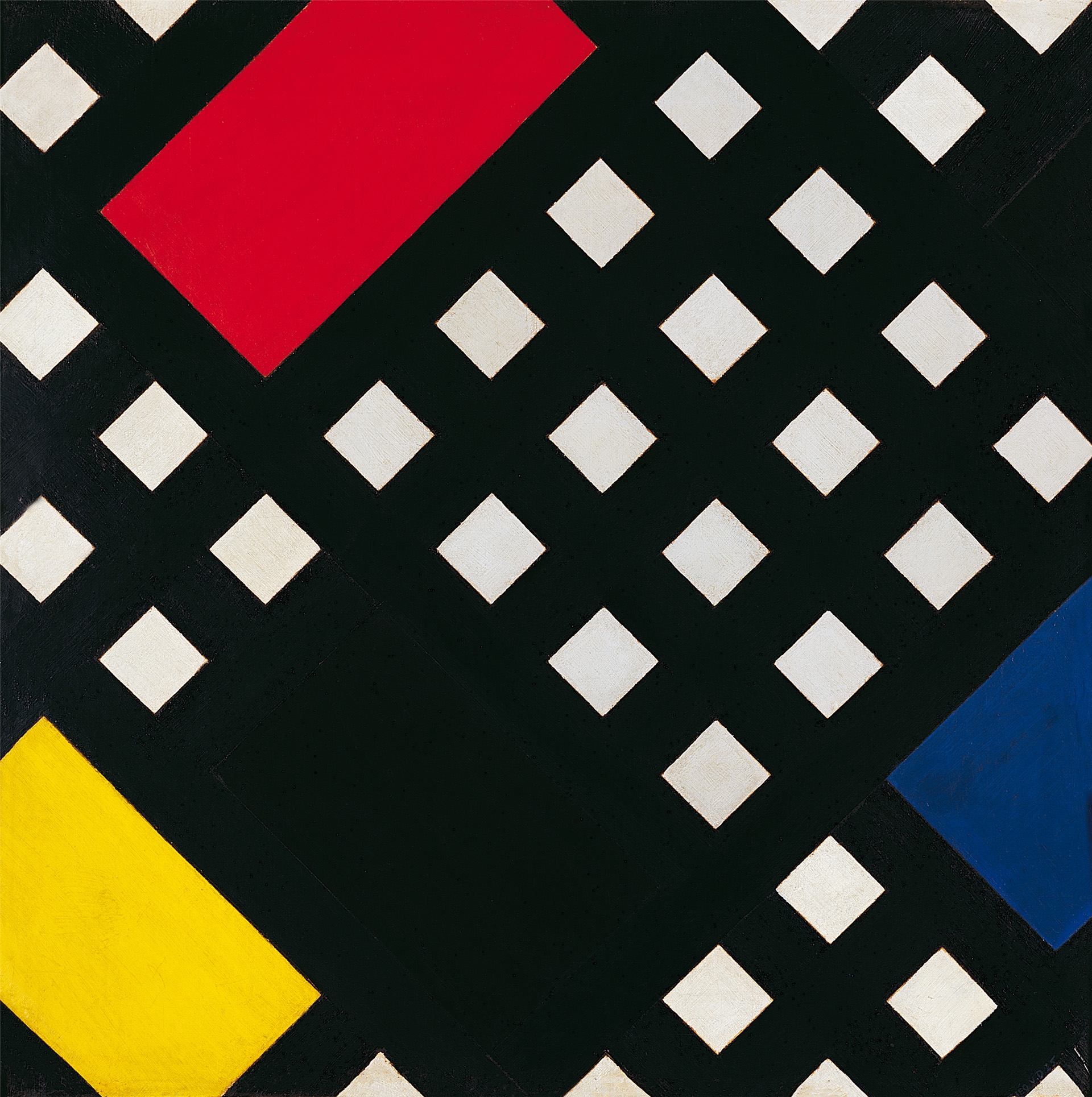
Theo van Doesburg, ‘Counter-Composition XV (Contra-Compositie XV)’, 1925, oil paints, canvas, 50 × 50 cm, Muzeum Sztuki in Łódź
Behind the idea of organizing a museum collection of modern art was a realistic evaluation of avant-garde art’s social influence in Poland. This evaluation brought Strzemiński to the conclusion that “[i]t is not enough to produce a work of art […]. It is necessary to create the conditions for it to have an impact.”[79] Strzemiński saw avant-garde art as an instrument of social change, and so its promotion and the popularization of its ideas, paving the way for its wider acceptance and understanding, were matters of utmost significance to him.
Popularizing and educating were the main rationales behind the founding of a.r. The group pursued this mission through exhibitions, lectures, and publications. The “a.r. Library” was launched, going on to publish seven titles, including volumes of avant-garde poetry in Strzemiński’s revolutionary graphic design, but also theoretical essays devoted to avant-garde poetry, typography, and art. Moreover, Strzemiński promoted modern artistic ideas through articles published in the professional and popular press as well as through his teaching. He taught at various vocational schools, and at some point an opportunity emerged for him to start his own school, a “kind of unorthodox Bauhaus.”[80] This project, however, quickly fizzled out, and the school never materialized.[81]
As we can see, the means Strzemiński and a.r. employed in their mission to popularize modern art were highly diverse, but it was the museum to which he ascribed the main role: “the museum takes center stage in shaping artistic culture.”[82] Strzemiński was fully aware of the social prestige enjoyed by the institution of the museum, as it was perceived as the definer and guardian of canon and a key codifier of national imagery, and he was keen to strategically exploit its symbolic capital.[83]
The Museum According to Strzemiński
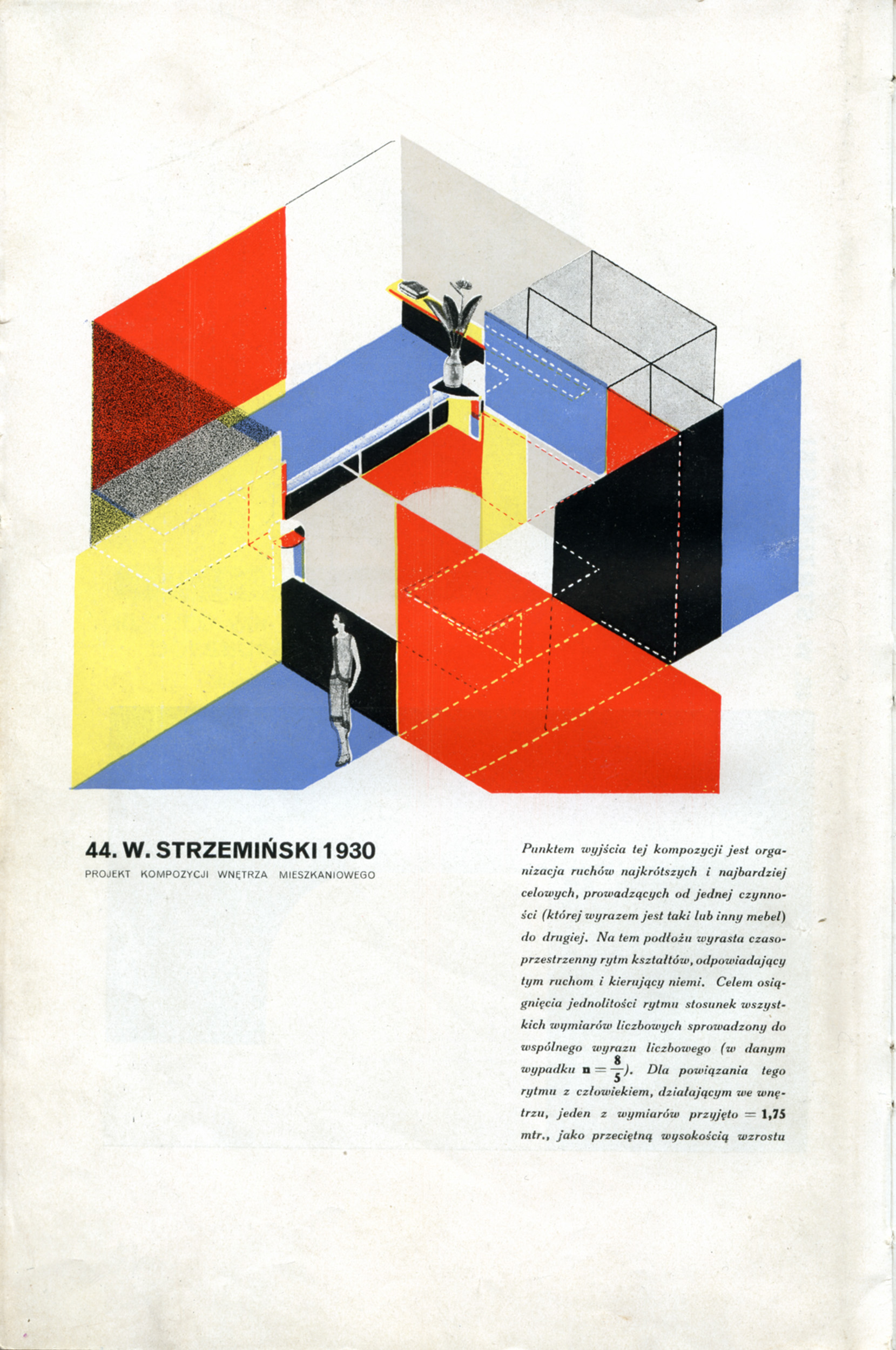
Władysław Strzemiński, the project of interior design composition, 1930, illustration in: Katarzyna Kobro, Władysław Strzemiński, ‘The composition of space. The calculation of the rhythm and space’, The „a.r.” Library vol. 2, Łódź 1931, illustration 44, the archive of Muzeum Sztuki, Łódź © Ewa Sapka Pawliczak and Muzeum Sztuki in Łódź
The primary task Strzemiński envisaged for the museum was raising the level of artistic culture, which he deemed very low in Poland because, as he metaphorically put it, of the lack of proper “roots for artists and a ladder for the public.”[84] He was very critical of Polish culture, accusing it of celebrating passéist attitudes and a nostalgic longing for a romanticized past, therefore entrenching a conservative social order and anachronistic beliefs about the world, in no way preparing Poles to live in the modern reality, let alone encouraging them to change it.[85] He saw a close connection between widespread aesthetic preferences and dominant social attitudes, perceiving Polish society’s aversion to modern art as a symptom of a general hostility towards the civilizational project of modernity.[86] Making the public familiar with works of avant-garde artists, lending them respectability, the museum was meant to expand the field of social acceptance not so much for art itself as for the project of which it was an emanation.[87]
Unlike Kandinsky’s conception, legitimacy would not be based here on the construction of a narrative presenting the avant-garde as a necessary culmination of art history.[88] The surviving photographs do not make it possible to fully reconstruct the a.r. collection’s first exhibition at the Łódź museum, but they do make it clear that it was not arranged in a historicizing order. The layout seems associative, but perhaps—though proving this intuition would require further research—it served to illustrate certain formal and constructional issues as well as how the various modern art movements sought to solve them. The installation would then be more in line with what Rodchenko envisaged, stating that the adjacency of “artists and works should correspond to the stages of development of artistic forms.”[89] For Strzemiński, the museum was not only a means of educating the public, but also a place where artists would study what has already been achieved in art—an archive of existing innovations it is necessary to know to create new ones. Strzemiński’s museum differed, therefore, from Rodchenko and Stepanova’s museum-as-laboratory in that instead of ready-to-use patterns and, theoretically, immediately implementable solutions it contained a “documentation” of the successive stages of prototyping. These needed to be analyzed, but only to be rejected at some point in favor of a more advanced solution. According to Andrzej Turowski, these assumptions made Strzemiński’s museum a “critical institution,” serving to identify the shortcomings of existing art and thus to encourage its further development.[90] “Only those who have acquainted themselves with all things past and present,” Strzemiński wrote, “and have maintained an independent critical attitude toward them, can make modern art.”[91] Prototyping, according to this logic, was a never-ending process, and, importantly, one that could be carried out solely on the condition of total artistic autonomy. Only the latter creates ample space for free experimentation, unhindered by any preconceived utilitarian goals—and only such experimentation is capable of achieving genuine innovations.[92] This logic provided Strzemiński’s museum with a foundation for an enduring existence, whereas the vision of art underpinning Rodchenko’s and Stepanova’s museums of artistic culture had, in principle, to result in the discontinuation of these institutions or, alternatively, their transformation into research institutes working for state-implemented modernization and industrialization.
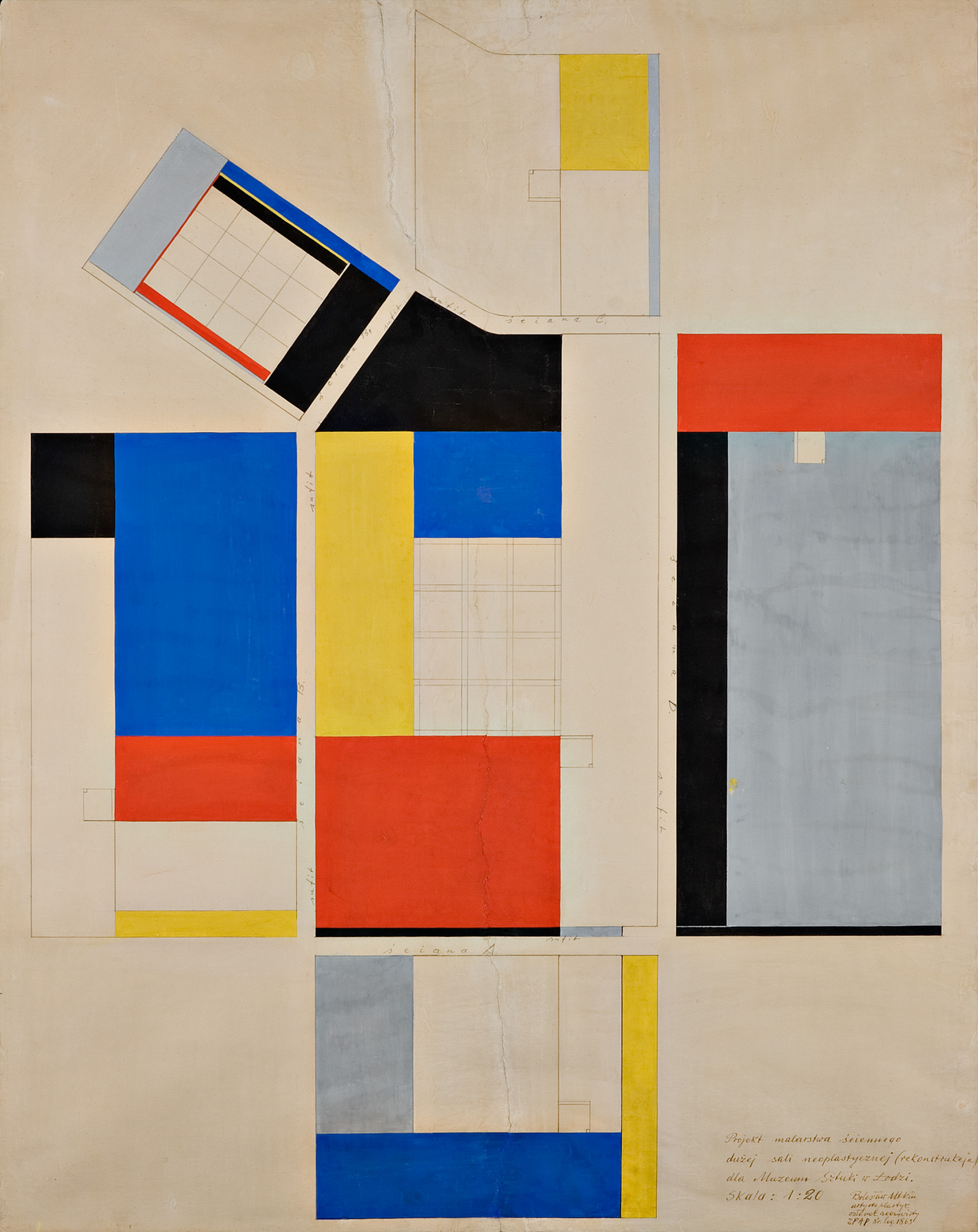
Bolesław Utkin (according to Władysław Strzemiński), project of re-creation of the painting decoration of The Neoplastic Room for Muzeum Sztuki in Łódź, Muzeum Sztuki in Łódź
Strzemiński was critical of any attempts to encroach upon or undo art’s autonomy, not only those that sought to reduce the artist to industry support, but also those that equated art with propaganda.[93] The latter, he believed, rendered art sterile, retarding the spectator’s perceptive abilities instead of heightening them. By seeking an immediate and popular effect, propaganda appealed to the most deeply ingrained, and therefore most conservative aesthetic preferences.[94] Profoundly convinced that only socially relevant art made sense, Strzemiński argued that the point was not to promote any expressly formulated political views through art, but rather to draw politically meaningful conclusions from the exploration of artistic form: “I’m not talking about political agitation or ‘expressing’ political positions through art, but about the logic of an existential attitude […] resulting from the logic of artistic forms.”[95] Art was meant to serve as the prototype of a rational organization of life, its role being to develop new, ever-improving organizational models using its intrinsic means.[96] Those, in turn, were to be translated by engineers and political decision-makers into concrete solutions for organizing spaces for human activities. The purpose of modern art was, through its constructional values, to directly affect the recipients’ imagination and to awaken pro-social and pro-development attitudes based on a desire for rational order, harmony, and social unity. As Strzemiński capsulized it,
“[t]he functionality of the painting can only be justified as a visual experiment, as an experimental laboratory study of an artistic concept, as an invention that inspires utilitarian-manufacturing opportunities or directly augments overall social activity and energy. We need a painting that, through its inventiveness, increases overall social activity and energy.”[97]
The museum’s role was to enhance those functions of art, and as such, we may assume it was meant to address itself to three kinds of public, placing each in a different temporality. The mass public was confronted with the history of the development of modern art, becoming familiar with its language and, in this encounter, building up its own pro-modernization attitudes and “increasing overall social activity and energy.” Designers, technicians, and social engineers were able to acquaint themselves with the most advanced artistic achievements to use them as inspiration for designing practical solutions to improve the quality of contemporary life. Artists, in turn, analyzed the shortcomings of their predecessors’ works and perfected their own technique so that, in the course of free experimentation, they could take art further and make it capable of responding to the challenges of the future.[98]
From such a perspective, the autonomy of art, and the institution of the museum as its safeguard, did not threaten the avant-garde social project; on the contrary, they were indispensable to its realization.

The Neoplastic Room, Muzeum Sztuki in Łódź, 1948, design: Władysław Strzemiński, re-creation of the painting decoration: Bolesław Utkin, view from 1960-1966, the archive of Muzeum Sztuki in Łódź
The Neoplastic Room
The final chapter of Strzemiński’s museology was his design, in 1946, of one of the Łódź museum’s exhibition rooms.[99] As the museum had been moved after the Second World War to a new, much larger space—the nineteenth-century palace of one of the city’s industrial tycoons—its director, Marian Minich, initiated efforts to reorganize the permanent exhibition. Informed by the philosophy of the Vienna school (Alois Riegl), he systematized the works so that they visualized the history of art as a sequence of styles conceived as a logical development—from Impressionism and Postimpressionism, through Expressionism, Cubism, to Constructivism, Neoplasticism, Unism, and, separately, Surrealism.[100] Minich commissioned Strzemiński to design the room devoted to neoplastic tendencies, which was the central point of the show.[101]
The artist covered the walls and ceiling with uniform surfaces of the basic colors (red, blue, yellow) and non-colors (black, gray, white), arranged in a grid of simple divisions defined by a geometry of vertical and horizontal lines. The room displayed works by members of De Stijl (Vilmos Huszar, Theo van Doesburg, Georges Vantongerloo) and artists from that circle (Jean Hélion, Sophie Taeuber-Arp, Henryk Stażewski), as well as Kobro’s spatial compositions of the 1920s, for which the principles of Neoplasticism were among the more important points of reference. Complementing the set-up were furniture pieces and display stands of indeterminate function devised by Strzemiński, reminiscent of Gerrit Rietveld’s design.
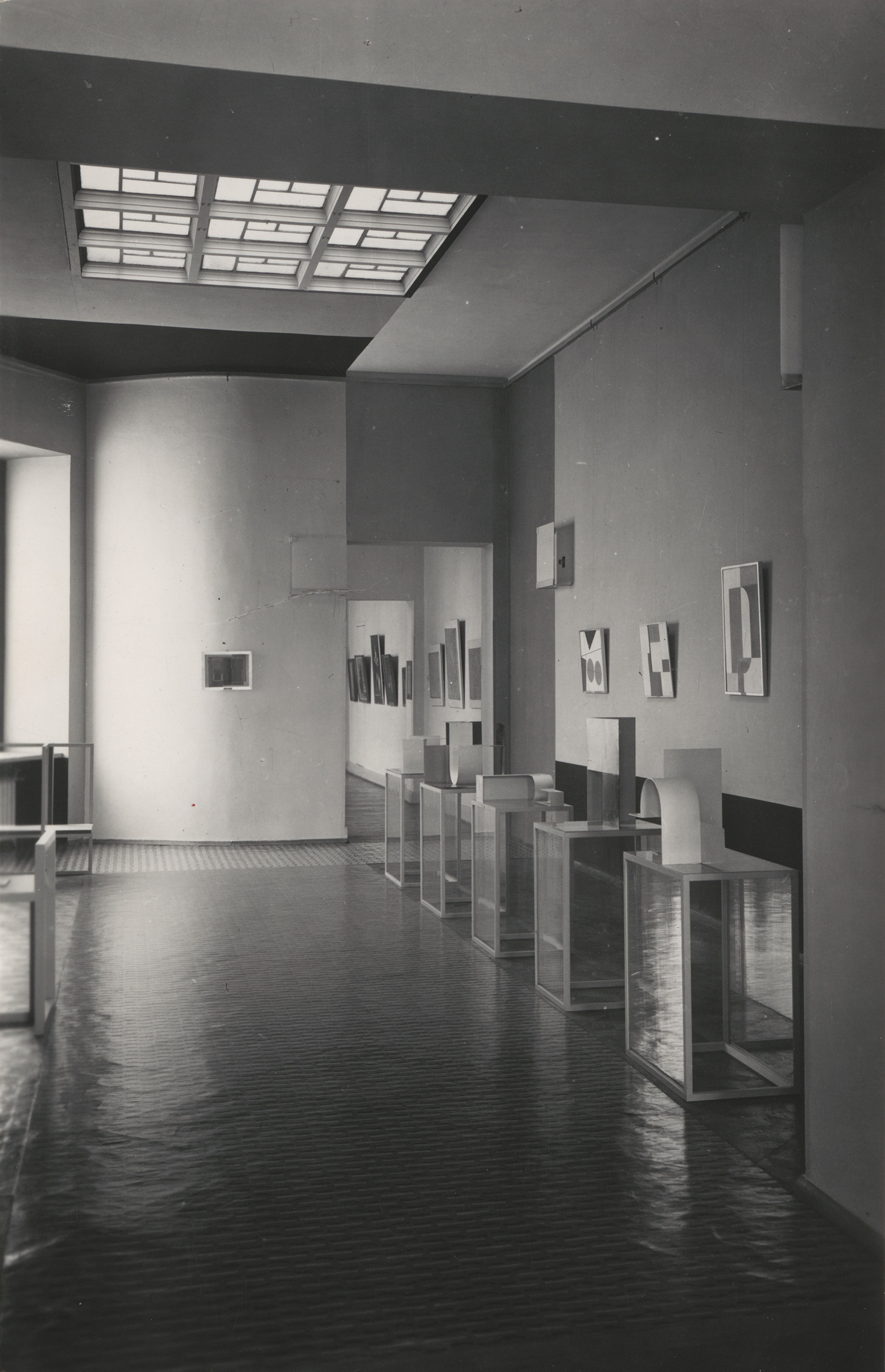
The Neoplastic Room, Muzeum Sztuki in Łódź, 1948, design: Władysław Strzemiński, view from before 1951, the archive of Muzeum Sztuki in Łódź
It may be suspected that Minich wanted to give the room and this room only a special architectural setting, since he viewed Neoplasticism as a movement that realized itself primarily in architecture and applied design.[102] The idea was probably also to demonstrate the practical dimension of avant-garde art, and thus to convince the general public that this art served a purpose.[103] This legitimacy was becoming an urgent issue at a time when functionaries of the new system, demanding that socialist realism be decreed as the only acceptable artistic doctrine, were ever-more fiercely accusing avant-garde art of asocial formalism. For Strzemiński, in turn, the Neoplastic Room was a first opportunity to actually test the theoretical assumptions he and Kobro had formulated back in the late 1920s. According to those, architecture was to shape human life by organizing the activities of both work and leisure in a rational and economical manner. As Strzemiński wrote, “The ultimate purpose of architecture is to […] serve as a regulator of the rhythm of social and individual life.”[104] The complication of this rhythm meant it should take into consideration not only the regulatory function of shapes and spatial divisions, but also of colors and textures, through which the “ebbs and flows of man’s functional energy” could be properly directed.[105] The rhythmization of forms and colors in the Neoplastic Room was subordinated to this purpose of directing the spectator’s bodily movements and gazes. It seems, however, that the artist was not interested in disciplining the spectator, in forcing them to adopt a particular, pre-programed viewing angle. Pointing to the educational aspect of the museum exhibition,[106] Strzemiński stressed, as Lissitzky did, that modern art should not reduce the spectator to the role of a passive recipient. This, he believed, was the difference between modern (autonomous) and historical art: in the past the “work of art was meant to stupefy and narcotize, causing the spectator to passively experience dictated emotions, to passively receive suggestions and fluids, molding a spectator that was uncritical, passive, and submissive,” whereas contemporary artistic tendencies “appealed first and foremost to the intellectual and active components of the psyche, requiring the spectator be able to think abstractions, to connect disparate phenomena, and to actively develop the concept.”[107] Offering the spectator a labyrinth of original spatial and color relationships, the arrangement of the Neoplastic Room seeks to cultivate and appeals to precisely such faculties.
It may seem anachronistic for Strzemiński to have used Neoplastic aesthetics, developed two decades earlier, in the late 1940s, and had the Neoplastic Room been an art project, one could rightly speak of anachronism here. It was, however, conceived as a museological project; Strzemiński positions himself not as an artist, but as a curator “exhibiting” Neoplasticism, and a designer implementing formal solutions developed on its basis, testing their effectiveness in the execution of a specific architectural task. To draw upon the distinction introduced by Dan Sperber and Deirdre Wilson, the visual language of Neoplasticism is not so much “used” as “mentioned” here,[108] and the actual semantic framework is provided by Kobro’s and Strzemiński’s prewar spatial experiments as well as the latter’s preoccupation, contemporary with the Room, with the issue of “visual content” and the conscious shaping thereof.[109] The Neoplastic Room would thus appear as a kind of “Demonstrationraum,” construed, however, not as a model for other exhibition spaces, but rather as an example, to demonstrate how the modern visual language can be employed to create environments that incite active and creative viewing.
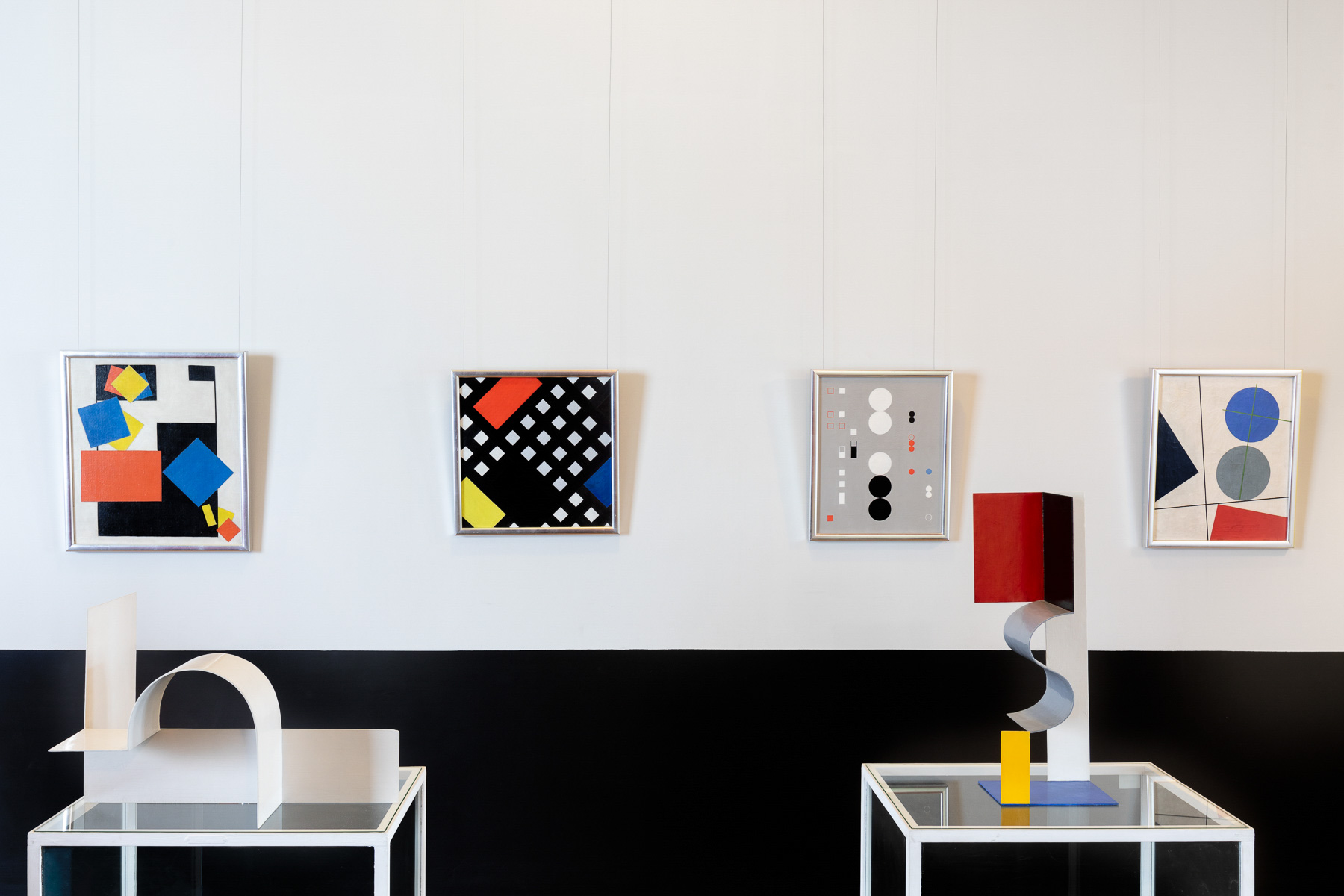
Władysław Strzemiński, The Neoplastic Room, present view, 2020, photo: Anna Zagrodzka, the archive of Muzeum Sztuki in Łódź
What Is an “Avant-Garde Museum”?
The institutions mentioned in this essay were not, of course, the only ones that collected and exhibited avant-garde art. Collections, galleries, and finally museums (New York’s MoMA was first) started emerging almost concurrently with the rise of the avant-garde itself. What distinguished the museums of artistic culture, the Kabinett der Abstrakten, the Société Anonyme, and the a.r. collection from other such institutions was the fact that they were initiated and co-created by avant-garde artists themselves. Whether and how this determined their specifics and uniqueness should be the subject of further study. But today a number of aspects can be discerned that, we may cautiously argue, make them a distinct phenomenon.
Firstly, none of these initiatives sought to create yet another institution operating within the existing system and only differing from other museums in that it would show contemporary art. The avant-garde posited a transformation of human reality, and this was something no individual institution could ensure. Consequently, all these initiatives went hand-in-hand with efforts to establish a completely new system of distribution and dissemination, one that would make it possible to “inject” contemporary art into the bloodstream of the social body and thus enable its transformation. Collection-building and exhibition-staging were not all; lectures and talks were organized, books and catalogs published. To reach a broad and diverse public, existing infrastructure—municipal and regional museums, galleries, art schools, community clubs and so on—was often utilized. In each of the above projects, the idea of establishing a museum network was discussed, at least at a certain stage. The museums of artistic culture are the most obvious case in point here, but the Société Anonyme also envisaged setting up branches in other US cities. In 1920, the first version of the “Its Why and Its Wherefore” brochure, presenting the organization’s goals, mentions plans to institute a “chain of Galleries and Reference Libraries where these expressions of this present desire of the modern artist can be studied throughout the country.”[110] Those plans never came to fruition, but the Société worked together with several dozen private galleries, colleges, and educational societies around the country. It might be surmised that Strzemiński, too, thought about a museum network. It was he, in all likelihood, who was behind the anonymous note, published in an issue of Blok, that mentioned the need for a Museum of Art. The note suggested that the Museum would “organize traveling exhibitions, working to start similar museums on a smaller scale in provincial cities.”[111] While El Lissitzky did not formulate such postulates, he designed the Kabinett der Abstrakten in the hope it would inspire similar such projects, setting a “standard for other spaces in which new art is shown to the public.”[112]
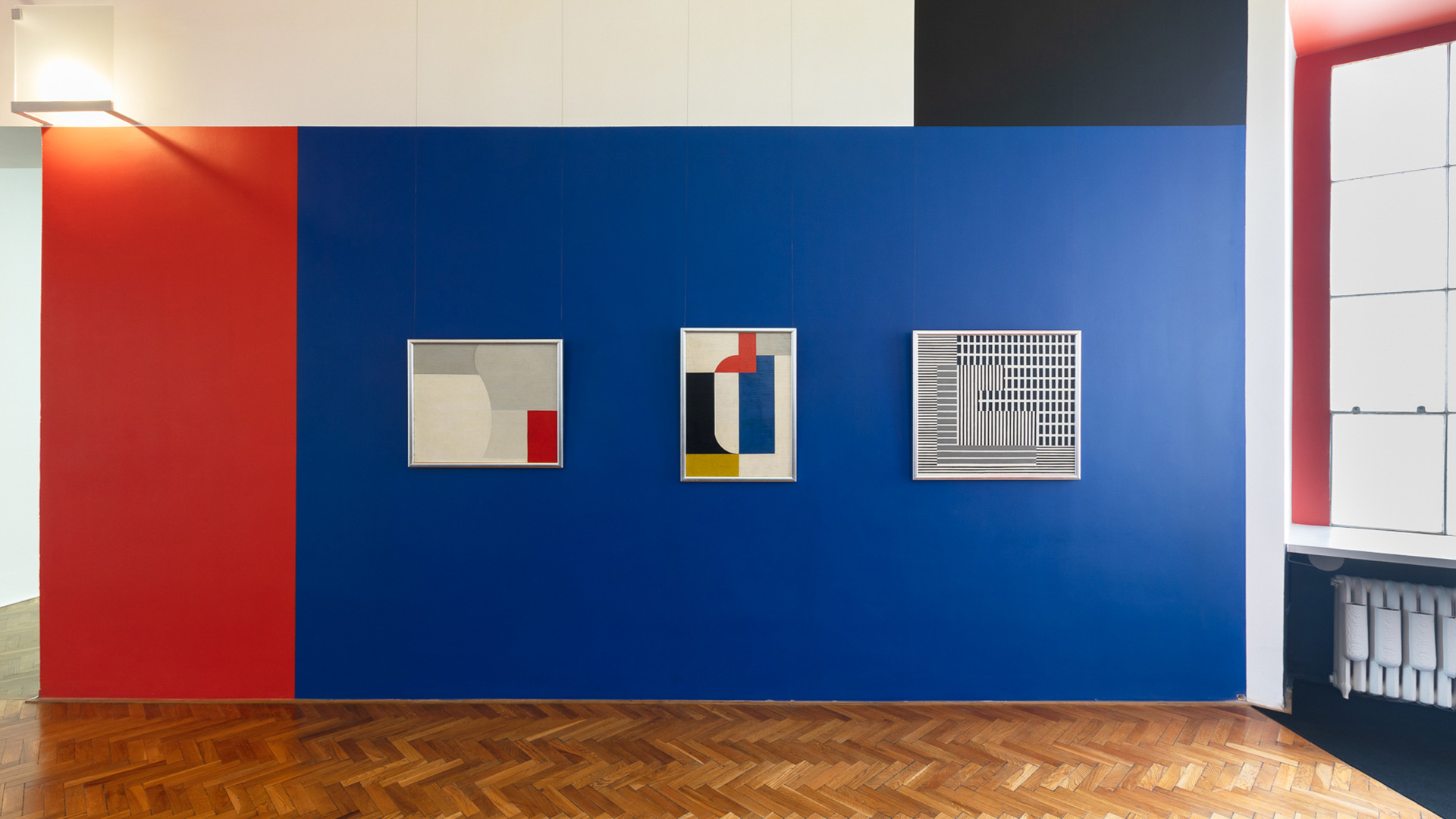
Władysław Strzemiński, The Neoplastic Room, present view, 2020, photo: Anna Zagrodzka, the archive of Muzeum Sztuki in Łódź
The second distinguishing feature of the projects mentioned was their position toward art history. The avant-garde appreciated the gravity of the museum’s symbolic capital, but it rejected the authority of the past and of the science, closely connected with the museum, dedicated to studying it. “We must not allow,” Malevich stated firmly during the debate on the museums of artistic culture, “our backs to be platforms for the old days.”[113] Museums were meant to support the education of “artists of living forms rather than dead representations of objectivity,” to forge the new human, rather than “burden his back with all the robes and togas of the past.”[114] Only such historical works whose inventiveness would serve as fresh inspiration for living artists would be preserved.[115] At the same time, the artistic past was to be presented as a “road already traveled by” rather than something still worthy of imitation and “bowing down” to.[116] In order to perform its educational function, the past had to be freed from the bonds in which art history had tried to squeeze it. The final declaration of the Petersburg museum conference urged, “Artists! Free past art from dead historical pedantry!”[117] An irreverent attitude towards art history was also manifested by members of the Société Anonyme. Dreier stressed that their collection had special value because it had not been created according to expert hierarchies.[118] She accused art historians of being guided by narrowly conceived rationality, alleging that their perspective was exclusively intellectual and ignored the spiritual dimension of the work: that “through their historic attitude of mind, they are often blocked from recognizing the seed from which the tree will grow.”[119] This critical attitude was evident in the design of the Brooklyn Museum exhibition. As Renate Wiehager notes, instead of showing works organized by styles and movements, those hypostases of the art history of the day, Dreier and Duchamp “chose an associative, open arrangement for the exhibition with the aim of allowing the viewer to experience visually both the unifying moment of a universal, ‘cosmic’ connection between the individual artists and the kaleidoscopic diversity of modern art.”[120] Also, Lissitzky’s Kabinett der Abstrakten, as researchers such as Maria Gough or Sandra K. Loschke convincingly demonstrate, contesting the precepts of Dorner’s curatorial concept, effectively undermined the stylistic history of art that formed its theoretical basis.[121] The art historian’s and avant-garde artist’s different attitudes to the past were also evident in a dispute that arose between Strzemiński and Minich, when the latter, having been put at the helm of the Łódź museum, reorganized the permanent exhibition. The new arrangement was based on the principle of the “equal treatment of all art periods”; works from the a.r. collection, previously crowded into two isolated rooms, were now joined with works from other collections, producing a uniform narrative that demonstrated, in keeping with the Wölfflinian model Minich preferred, the evolution of art from the mid-eighteenth to the twentieth century.[122] This change met with a critical reaction from Strzemiński, expressed in an article published in one issue of the Łódź periodical Forma in 1936. Its author criticized the exhibition for putting phenomena that contributed to art’s development on an equal footing with art that led it astray, resulting in regression. The article claimed that the museum should only present the “growth tendencies of each period and the components out of which true art worthy of its epoch is made.”[123] For, as Strzemiński notes elsewhere, turning toward the past only makes sense when it stimulates art’s further development.[124] The antagonism reflected in the polemic can be summarized as the difference between a kind of presentism, i.e. viewing the past through the lens of present-day judgments (and interests), and a kind of absolutism, i.e. the belief that there exists a vantage from which the past can be described in a completely impartial and “timeless” manner. While absolutism seems to have dominated in museology at the time, all the avant-garde projects discussed in this essay could be described as presentist.
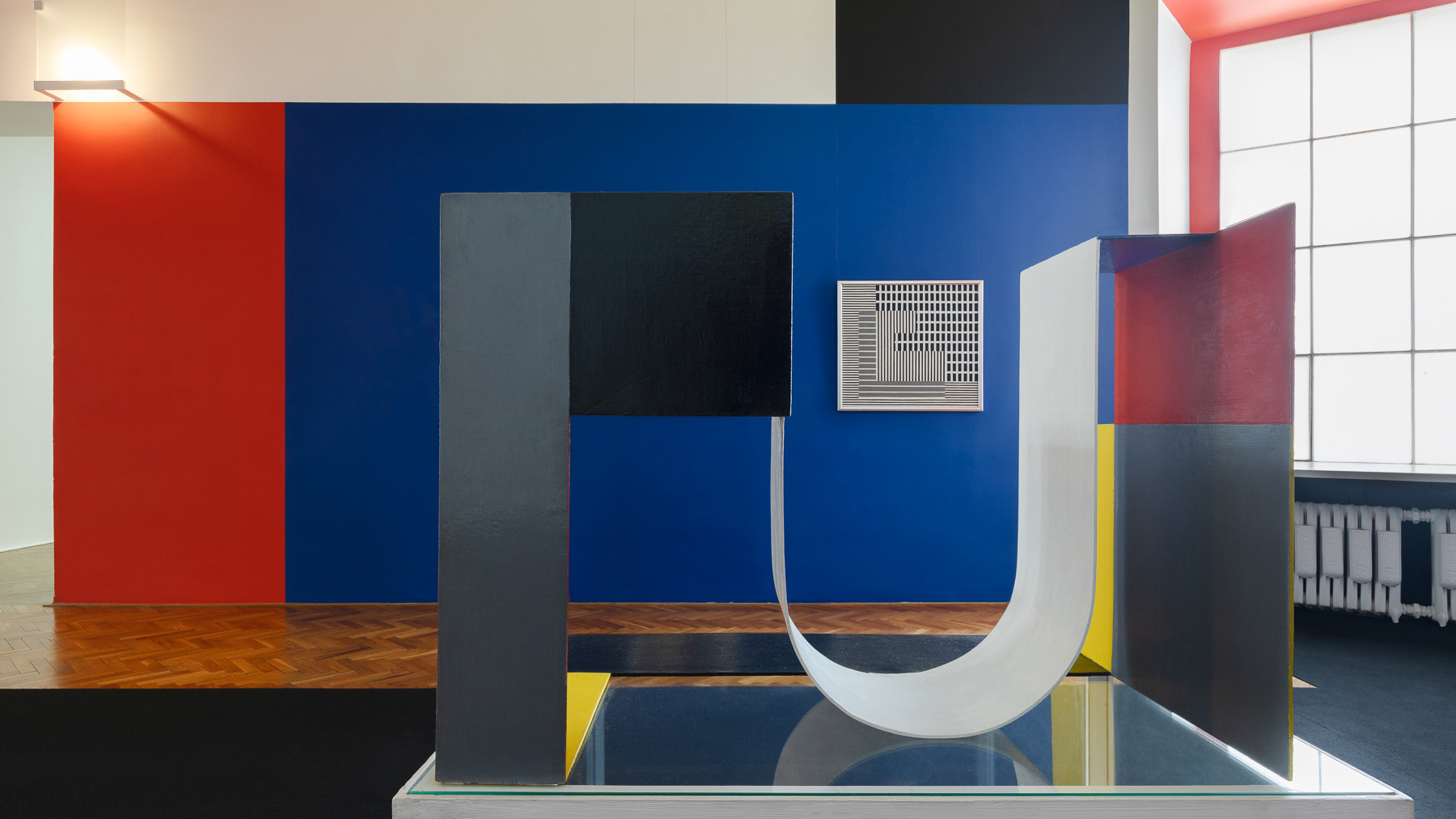
Władysław Strzemiński, The Neoplastic Room, present view, 2020, photo: Anna Zagrodzka, the archive of Muzeum Sztuki in Łódź
Those projects were also more democratic and inclusive, and this would be their third characteristic. Dreier used every opportunity to stress that the Société Anonyme collection contained works both by established figures and by those who, through their modest work, helped to popularize modern ideals; both by artists from the world centers and by those from peripheral regions. The Société Anonyme collected and exhibited works representing all essential artistic movements of the first half of the twentieth century; moreover, Dreier, a committed suffragette, made sure that women’s art was significantly represented. Though consisting almost entirely of works by artists from the Soviet republics, the collection created for the museums of artistic culture equaled their American peer in terms of stylistic diversity. Rodchenko stressed also that what mattered were not only works that gained recognition for their perfection, but also ones that, though imperfect, opened up new perspectives in art.[125] Even the a.r. International Collection of Modern Art, though much smaller than those mentioned above, featured examples of trends as diverse as Cubism and Futurism, Constructivism and Surrealism, Neoplasticism and organic abstraction, concrete art and metaphorical figuration, and besides works by Picasso and Legér, it held those by far lesser-known artists, such as the Russian émigré Serge Charchoune, Jean Lurçat from France, Hans Rudolf Schiess from Switzerland, and Hendrik Nicolaas Werckman from the Netherlands.
The inclusivity of avant-garde museum projects extended to the public as well and, potentially at least, entailed a less patronizing attitude to the spectator. What happened at the avant-garde museum was not so much a transfer of ready-to-consume knowledge as a stimulation of the work of the intellect and imagination. Through a proper arrangement of the works and a proper design of the exhibition space, the spectator was encouraged to be active, to develop the ability to view art independently, and to adopt the approved attitude to the world. This activating function of the museum was most emphatically articulated by Lissitzky, but it was also mentioned by other Russian avant-gardists, such as Malevich or Rodchenko. The closely associated critic Nikolai Punin directly addressed how an ill-conceived museum education patronized the mass (proletarian) audience, and demanded respect for the spectator’s subjectivity. He believed that a patronizing education could only produce consumers of art, whereas art should support the creative faculties.[126] Strzemiński, who was convinced that art needed to assume responsibility for the “full development of the active and intellectual capacities of the psyche”[127] and stimulate a creative attitude to life in everyone, not just artists, saw the role of art—and therefore, the museum—along similar lines.
An ambition to create new systems to socialize artistic production, a presentist approach to art history, a democracy of artistic choices, an inclusive and empowering attitude towards the spectator—these were the characteristics of the museological initiatives undertaken by avant-garde artists. These initiatives can be construed as yet another strategy to further the avant-garde’s goal of transforming social reality through art. The basic strategy was to implement projects that aimed at reorganizing the environment of daily life, in the conviction that this would change social conditions and shape a new and better person. The idea of establishing artistic institutions was underpinned by a reverse logic: they were to make avant-garde art widely available and understood, thus increasing the scope and power of its influence on the consciousness of the masses. Awakening in them and giving direction to a desire for change, it was ultimately to result in the establishment of a world based on a new, better, and fairer order.
This text first appeared in The Avant-Garde Museum, edited by Agnieszka Pindera i Jarosław Suchan, published by Muzeum Sztuki in Łodź, 2020.
[1] Theodor W. Adorno, “Valéry Proust Museum,” in Prisms, trans. Samuel and Shierry Weber (London: Neville Spearman, 1967), 175.
[2] Robert Smithson, “Cultural Confinement,” in Nancy Holt, ed., The Writings of Robert Smithson
[3] Peter Bürger, Theory of the Avant-Garde (1974), trans. Michael Shaw (Manchester and Minneapolis: Manchester University Press, University of Minnesota Press, 1984).
[4] There is a large body of literature on the museums of artistic culture. Seminal publications include: Svetlana Dzhafarova, “The Creation of the Museums of Painterly Culture,” in The Great Utopia: The Russian and Soviet Avant-Garde 1915–1932 (New York: Guggenheim Museum, 1992); Irina Karasik, ed., Muzei v muzee: russkii avangard iz kollekcii muzeia khudozhestvennoi kul’tury v sobranii Gosudarstvennogo Russkogo Muzeia (St. Petersburg: Gosudarstvennyi Russkij Muzei, 1998); Maria Gough, “Futurist Museology,” Modernism/modernity 10, no. 2 (2003, reprinted in this volume); Svetlana Dzhafarova, “The Museums of Artistic Culture – A Policy of Disseminating Modern Art,” InCoRM Journal 3 (2012); Arseny Zhilyaev, ed., Avant–Garde Museology (Minneapolis: University of Minnesota Press, 2015); Lyudmila Demidova, ed., Upon Request: Russian Avant-Garde Collections from Regional Museums. Part I (Moscow: Jewish Museum and Tolerance Center, 2016); Lyudmila Demidova, Maria Mikhailova, Peter Spinella, eds, Upon Request: Russian Avant-Garde Collections from Regional Museums. Part II (Moscow: Jewish Museum and Tolerance Center, 2017); Lubov R. Pchelkina, Andrey D. Sarabyanow, eds, Avangard. Spisok No 1: k 100-letiiu muzeia zhivopisnoi kul’tury (Moscow: Gosudarstvennaya Tret’yakovskaya Galereya, 2019). The pioneering Polish-language source is Andrzej Turowski’s article, “Muzea kultury artystycznej,” Artium Quaestiones, no. 2 (1983.)
[5] Turowski, “Muzea…,” op. cit., 90. Cf. Pchelkina, “Moskovskij muzei zhivopisnoi kul’tury. Istoria bez kupiur,” in Avangard. Spisok No 1…, op. cit., 9.
[6] The IZO-Narkompros Position adopted at the Petrograd conference identified artistic culture with a “culture of creative invention”; “Polozheniye otdela Izobrazitel’nykh Iskusstv i Khudozhestvennoy Promyshlennosti po voprosu iskusstva o ‘khudozhestvennoy kul’ture’,” Isskustvo Kommuny, no. 11 (1919,) 4.
[7] Kazimir Malevich, “O Muzee,” Iskusstvo kommuny, no. 12 (1919), 2. Based on the English translation, “On the Museum,” in Avant–garde Museology…, op. cit., 270 (trans. Xenia Glowacki-Prus and Arnold McMillin, all further quotes from this text follow their translation).
[8] Kazimir Malevich, “Nashi zadachi. Os’ tsveta i ob’ema,” Izobrazitel’noe iskusstvo, no. 1 (1919), 30 (author’s translation).
[9] “Deklaratsiya otdela Izobrazitel’nykh Iskusstv i Khudozhestvennoy Promystslennosti po voprosu o printsipakh muzeyevedeniya,” Iskusstvo Kommuny, no. 11 (1919,) 1.
[10] Ibid.
[11] The Moscow institution was officially called the “Museum of Painterly Culture,” a name Malevich staunchly opposed, believing it should occupy itself with all manifestations of creative experimentation—the culture of creative invention—rather than a single discipline defined according to anachronistic criteria; Malevich, Nashi zadachi. Os’ tsveta…, op. cit., 28.
[12] Vassily Kandinsky, “Muzei Zhivopisnoi Kul’tury,” Khudozhestvennaia Zhizn, no. 2 (1920).
[13] Aleksandr Rodchenko, O Muzeynom Biuro: Doklad na konferentsii zaveduiushchikh Gubsektsiiami IZO [1920]; English translation by Jamey Gambrell in Avant-Garde Museology…, op. cit., 301–3. Between February 1920 and July 1922, Malevich ran both the Museum of Painterly Culture in Moscow and the Museum Bureau, a central unit reporting to the IZO-Narkompros, tasked with building a nationwide contemporary art collection and then distributing the works among regional museums; cf. Pchelkina, Moskovskij muzei…, op. cit., 12–17.
[14] Varvara Stepanowa, Čelovek ne možet žit’ bez čuda: Pis’ma. Poetičeskije opyty. Zapiski chudožnicy, ed. О. Mel’nikova (Moscow: Sfera, 1994), 96.
[15] Among the divisions of the new type of museum, an IZO–Narkompros ordinance dated 20 February 1921 mentions “production art,” which would conduct research into materials for the purposes of consumer-goods production; “Polozheniye o muzeyakh zhivopisnoy i plasticheskoy kul’tury,” in Muzej v muzee: russkij awangard…, op. cit., 355.
[16] Rodchenko, O Muzeynom Biuro…, op. cit., 303. As Stepanova reminisces, the first exhibition at the Moscow museum, in the part that Rodchenko was responsible for, had been organized around formal issues he found crucial, such as faktura, decorativeness versus emptiness, or effect of color; see Stepanowa, Čelovek ne možet..., op. cit., 119–20.
[17] Malevich, Nashi zadachi. Os’ tsveta…, op. cit., 30.
[18] Kazimir Malevich, “Otchet o deyatel’nosti khudozhestvenno-stroitel’nogo podotdela (Dekabr’ 1918 goda),” in Malevich o sebe. Sovremenniki o Maleviche. Pisma, dokumenty, vospominani’a, kritika, vol. I, eds. Irina A. Vakar and Tatiana H. Mikhyenko (Moscow: RA, 2004), 411.
[19] Rodchenko, O Muzeynom Biuro…, op. cit., 303.
[20] Varvara Stepanova, “On Constructivism,” in Varvara Stepanova: The Complete Work, ed. John Bowlt (Cambridge, Mass.: MIT Press, 1988), 173–4.
[21] Gough, “Futurist Museology,” op. cit., in this volume, p….
[22] According to Rodchenko’s report from 29 November 1920, a total of thirty museums were established in 1919–20, with local artistic communities asking for the establishment of another sixteen, of which six were feasible. Cf. the report’s English translation: “Report on the factual activities of the Museum Bureau,” in Avant–garde Museology…, op. cit., 305. However, only two museums—the Moscow and Petrograd ones—were more permanent structures; the others were either cells of existing museums or merely collections of works that these museums had received from the Moscow Bureau; cf. Dzhafarova, “The Museum of Artistic Culture…”, op. cit., 25–26.
[23] Turowski, “Muzea…,” op. cit., 99–100. Pchelkina, “Moskovskij muzei…”, op. cit., 26.
[24] Gough, “Futurist Museology,” op. cit., in this volume, p….
[25] Pchelkina, “Moskovskij muzei…”, op. cit., 25–26; Karasik,“Petrogradskiy muzey khudozhestvennoy kul’tury,” in Muzej v muzee: russkij avangard…, op. cit., 9–33.
[26] Among the many publications discussing El Lissitzky’s project, we might mention Beatrix Nobis, “Das Abstrakte Kabinett in Hannover und andere Demonstrationsräume El Lissitkys,” in El Lissitzky 1890–1941. Retrospektive, (Halle: Staatliche Galerie Moritzburg, 1988), 220–23. Exhibition catalog; Beatrix Nobis, “Der ‘Raum der Abstrakten’ für das Provinzialmuseum Hannover 1927/28,” in Die Kunst der Austellung. Eine Dokumentation dreißig exemplarischer Kunstausstelungen dieses Jahrhunderts, eds. Bernd Klüser and Katharina Hegewisch (Frankfurt am Main: Insel Verlag, 1991), 76–83; Maria Gough, “Constructivism Disoriented: El Lissitzky’s Dresden and Hannover ‘Demonstrationsräume’,” in Situating El Lissitzky. Vitebsk, Berlin, Moscow, eds. Nancy Perloff and Brian Reed (Los Angeles: Getty Research Institute, 2003), 77–125; Cornelia Oßwald-Hoffmann, Zauber… und Zeigeräume. Raumgestaltungen der 20er und 30er Jahre (München: Akademischer Verlag, 2003), especially 344–47 and 366–69; Charlotte Klonk, Spaces of Experience. Art Gallery Interiors from 1800 to 2000 (New Haven—London: Yale University Press, 2009), 113–21; Ines Katenhusen, “Modern aesthetics must become self-transformation: The Abstract Cabinet by El Lissitzky and Alexander Dorner 1926/27 in Hanover,” in New exhibition design 1900-2000, eds. Anna Müller, Frauke Möhlmann (Stuttgart: Avedition, 2011), 104–08; Sandra Karina Löschke, Materiality and Mediality: Display Strategies In Weimar Exhibition Environments (1923–1930), a PhD thesis defended at the University of New South Wales in 2014, 107–63.
[27] Alexander Dorner, “My Experiences in The Hanover Museum (What Can Art Museums Do Today?)” (1938), in Why Art Museums? The Unfinished Work of Alexander Dorner, eds. Sarah Ganz Blythe and Andrew Martinez (Cambridge, Mass.: MIT Press, 2018), 149–60; see also the volume’s other articles on Dorner’s museological concepts. Other publications on the subject: Monika Flacke, “Alexander Dorner,” in Avantgarde und Publikum. Zur Rezeption avantgardischer Kunst in Deutschald 1905– 1933, ed. Henrike Junge (Köln-Weimar-Wien: Böhlau Verlag, 1992); Joan Ockman, “The Road Not Taken: Alexander Dorner’s Way Beyond Art,” in Autonomy and Ideology: Positioning an Avant– Garde in America, ed. Robert E. Somol (New York: Monacelli, 1997), 80–120; Ines Katehusen, Alexander Dorner (1893–1957): A German Art Historian in the United States, AICGS/DAAD Working Paper Series (Washington: Johns Hopkins University, 2002); Tobias Wall, Das unmögliche Museum. Zum Verhältnis von Kunst und Kunstmuseen der Gegenwart, (transcript, Bielefeld, 2006), 193–224; Sandra Karina Löschke, “Material aesthetics and agency: Alexander Dorner and the stage managed museum,” Interstices, no. 14 (2013,) 26–37.
[28] Sandra Karina Löschke, “Material aesthetics and agency…,” op. cit., 26–27.
[29] Rebecca Uchill, “Storehouse to Powerhouse: The Museum Perspectives of Alexander Dorner,” in Why Art Museum?…, op. cit., 53.
[30] Alexander Dorner, The Way Beyond “Art” (New York: New York University Press, 1958), 17.
[31] See Rebecca Uchill, “Why Have Art Museums? Alexander Dorner, El Lissitzky, and the Dimensions of History,” in this volume, p….
[32] Alexander Dorner, “Zur abstrakten Malerei: Erklärung zum Raum der Abstrakten in der Hannoverschen Gemäldegalerie,” Die Form: Monatsschrift für gestaltende Arbeit, no. 4 (1928), 111–13. On Dorner’s interpretation of abstract space and its difference from conventional space, see Uchill, Storehouse to Powerhouse…, op. cit., 45–52.
[33] The relationship between Dorner and Lissitzky and the question of their actual contribution to the design of the Kabinett der Abstrakten have been a matter of controversy. According to Katehusen, the cabinet was created by Dorner “in close collaboration” with Lissitzky (Alexander Dorner…, op. cit., 5). Ockman describes the cabinet as their joint work (“The Road Not Taken…,” op. cit., 90–91), while Nobis believes it was an expression of Lissitzky’s fascinations rather than Dorner’s (“Das Abstrakte Kabinett…,” op. cit., 223). Oßwald-Hoffmann argues that by including the Kabinett der Abstrakten in his museological narrative, Dorner made a simplifying “translation” of Lissitzky’s concept (Zauber…, op. cit., 367–8). Gough goes the farthest, suggesting that the museum director’s and artist’s intentions were contradictory (“Constructivism Disoriented…,” op. cit., 77–125).
[34] Moreover, both rooms presented works by similar artists, including Willi Baumeister, Naum Gabo, László Moholy-Nagy, Piet Modrian, Oskar Schlemmer, or Lissitzky himself. On the Dresden project, see Kai-Uwe Hemken, “El Lissitzky’s ‘Room for Constructive Art’,” in Heike Biedermann, Birgit Dalbayeva, Andreas Dehmer, eds., Visionary Spaces: Kandinsky, Mondrian, Lissitzky and the Abstract-Constructivist Avant-Garde in Dresden 1919-1932 (Dresden: Staatliche Kunstsammlungen Dresden, 2019), 221–7. On the relationship between the Dresden and Hanover projects, see Gough, “Constructivism Disoriented…,” op. cit., 77–125.
[35] On the history and significance of the Prouns, see Tatyana Goryacheva, “The Proun Station,” in El Lissitzky, ed. Ruth Addison, Ekaterina Allenova (Moscow: State Tretyakov Gallery, Jewish Museum and Tolerance Center, 2017), 30–49. Exhibition catalog.
[36] The Proun concept found its spatial embodiment in the Proun Room that Lissitzky designed in 1923 for the Grosse Berliner Kunstausstellung; see El Lissitzky, “Prounenraum. Grosse Berliner Kunstausstelung 1923,” G–Material zur elementaren Gestaltung, no. 1, 1923, no page numbers. A detailed interpretation of the work can be found in Éva Forgács, “Definitive Space: The Many Utopias of El Lissitzky’s ‘Proun Room’,” in Situating El Lissitzky..., op. cit., 47–75.
[37] El Lissitzky, PROUN (1921), English translation after Forgács, “Definitive Space…,” op. cit., 56.
[38] “[A] new space impression that will exist only during the duration of the motion, and is therefore imaginary,” El Lissitzky, K. und Pangeometrie (1925), English translation: “A. and Pangeometry,” in El Lissitzky, Russia: An Architecture for World Revolution (Cambridge, Mass.: MIT Press, 1986), trans. Eric Dluhosh, 148. See also Nobis, “Das Abstrakte Kabinett…,” op. cit., 222.
[39] See Nobis, “Der ‘Raum der Abstrakten…’,” op. cit., 76.
[40] Lissitzky referred to his exhibition-room designs as Demonstrationsräume to stress that they should be considered as prototypes of a standard; El Lissitzky, Demonstrationsräume (1926-7?), English translation: “Exhibition Rooms,” in Lissitzky, Russia: An Architecture…, op. cit., 150.
[41] Ibid., 149.
[42] Lissitzky compares the exhibition space to a stage on which paintings appear like actors; see Sophie Lissitzky-Küppers, El Lissitzky: Maler Architekt Typograf Fotograf: Erinnerungen Briefe Schriften (Dresden: Verlag der Kunst, 1992), 71.
[43] El Lissitzky, “Exhibition Rooms,” op. cit., 150.
[44] “With each motion the visitor makes within the space of the room the effect of the walls changes: i.e., that which is black changes to white and vice versa. Thus an optical dynamic is created as a result of human motion. The game actively involves the viewer. (…) The viewer is tempted to slide the perforated cover plates up and down, discovering new paintings or covering up those that do not interest them. They are thus physically forced to involve themselves with the exhibition objects”; ibid., 151.
[45] A certain continuity can be discerned here, not only on an ideological level, but also in the context of specific solutions. For example, Lissitzky’s sliding screens bring to mind the moving panels which Nikolai Punin suggested mounting paintings on at museums; “On the Question of Museums: Record of the Discussion of Problems and Objectives of Fine Art Museums at the Art and Industry Boards” (1919) in Avant-Garde Museology, op. cit., 285.
[46] Gough, Futurist Museology…, op. cit., 341, in this volume, p…..
[47] See: Nobis, “Der ‘Raum der Abstrakten…’,” op. cit., 76. Gough goes so far as to suggest that Lissitzky’s goal was to produce a visual and corporeal experience of disorientation that would shake the spectator out of his routine viewing mode (as in Brecht’s V-Effekt). See Gough, “Constructivism Disoriented…,” op. cit., especially 114.
[48] On the history of the Société Anonyme, see Katherine S. Dreier, Marcel Duchamp, Collection of the Societé Anonyme: Museum of Modern Art 1920, ed. Georg Heard Hamilton (New Haven: Yale University Art Gallery, 1950); Ruth L. Bohan, The Société Anonyme’s Brooklyn Exhibition: Katherine Dreier and Modernism in America (Ann Arbor: UMI Research Press), 1982; Robert L. Herbert, Eleanor S. Apter, Elise K. Kenney, eds., The Societé Anonyme and the Dreier Bequest at Yale University: A Catalogue Raisonné (New Haven–London: Yale University Press, 1984); Jennifer R. Gross, ed., The Société Anonyme. Modernism for America (New Haven–London: Yale University Press, 2006).
[49] On Dreier’s biography and activities, see Frauke V. Josenhans, “A Museum Without Walls, For Artists By Artists: The Société Anonyme Collection,” in this volume, p….
[50] After the opening of Alfred H. Barr’s Museum of Modern Art in New York, to distinguish its initiative and stress historical priority, the Société Anonyme used the name “Museum of Modern Art 1920.” “Great confusion occurred,” wrote Dreier in a letter dated 16 February 1933 to John Barnes Pratt, “when Museum of Modern Art took our subtitle in 1929. Since then we have always added the 1920”; in Liena Vayzman, “Katherine S. Dreier’s Vision for a Country Museum: Integrating Avant- Garde Art and Modern Life in Rural Connecticut,” Yale University Art Gallery Bulletin, 2002, 52.
[51] Through her close contact with Kandinsky, Dreier knew about the new museums being created in Russia, but she had quite a vague and rather mistaken notion of their character; see Katherine S. Dreier, Western Art and the New Era (New York: Brentano’s Publishers, 1923), 110.
[52] Dreier, Duchamp, Collection of the Société Anonyme…, op. cit., 207.
[53] A telegram sent by Duchamp to Dreier on 16 January 1948, Katherine S. Dreier Papers / Société Anonyme Archive, Yale Collection of American Literature, Beinecke Rare Book and Manuscript Library, New Haven, Yale University, Box 12, Folder 324.
[54] Katherine S. Dreier, “Introduction,” in International Exhibition of Modern Art: Assembled by the Societé Anonyme (Brooklyn NY: Brooklyn Museum, 1926), unpaginated. Exhibition catalog.
[55] See Its Why and Its Wherefore (New York: Societé Anonyme, 1923 – a second, slightly revised edition of a brochure first published in 1920); Dreier, Western Art and…, op. cit.
[56] Letter sent by Sheldon Cheney of Société Anoyme’s Library Committee to Kenneth Macgowan, 18 March 1921. Quoted in: Jennifer R. Gross, “An Artists’ Museum,” in The Société Anonyme: Modernism…, op. cit., 6.
[57] Dreier, Western Art and…, op. cit., 71–72.
[58] Ibid., 136.
[59] The Société Anonyme ran its own gallery until May 1924, but already from 1921 onwards it staged exhibitions at other venues too. By 1939, it had produced over eighty shows, nearly sixty public events, and thirty publications. See The Societé Anonyme and the Dreier Bequest…, op. cit., p. 747–770, 773– 779.
[60] Dreier, Western Art and…, op. cit., 90.
[61] Its Why and Its…, op. cit., 4; Katherine S. Dreier, “Introduction,” in Dreier, Duchamp, Collection of the Societé Anonyme…, op. cit., XIV.
[62] Renate Wiehager, “Duchamp as Curator and Author for the Société Anonyme, 1920 to 1950: Autobiography and Art Theory in nuce”, inDuchamp als Kurator, eds. Renate Wiehagen and Katharina Neuburger (Köln: Snoeck, 2018), 5. Strongly informed by Theosophy, Dreier considered art to be an expression of a supra-individual spiritual entity and believed that the Société Anonyme’s mission was to make manifest this metaphysical dimension of art; see Kristina Wilson, “‘One Big Painting’: A New View of Modern Art at the Brooklyn Museum,” in The Société Anonyme: Modernism for…, op. cit., 87–88; in the same volume: Dickran Tashijan, “‘A Big Cosmic Force’: Katherine S. Dreier and the Russian/Soviet Avant-Garde,” 48–49. See also a defence of Theosophy in Dreier’s lecture “‘Intrinsic Significance’ in Modern Art,” published in: Charles Sawyer, ed., Three Lectures on Modern Art (New York: Philosophical Library, 1948), 7–8. Duchamp himself called the Société Anonyme “today the only sanctuary of esoteric character”; as cited in Wiehager, “Duchamp as Curator…,” op. cit., 20.
[63] Dreier, Western Art and…, op. cit., 74–75.
[64] Wilson, “‘One Big Painting.’ A New View…,” op. cit., 75. See also an exhaustive discussion of the show in Bohan, The Société Anonyme’s Brooklyn Exhibition…, op. cit., especially 51–66, and in this volume: o. k. group, “Bachelor Modernism: On the Société Anonyme’s International Exhibition of Modern Art, 1926,” p….
[65] Wilson, “One Big Painting”: A New View…, op. cit., 88.
[66] Modern Art, a catalog published on the occasion of the International Exhibition of Modern Art at the Brooklyn Museum, ed. Katherine S. Dreier (New York: Societé Anonyme, 1926). See Bohan, The Société Anonyme’s Brooklyn Exhibition…, op. cit, 67–82.
[67] Dreier, “Introduction,” in Dreier, Duchamp, Collection of the Societé Anonyme…, op. cit., XVII.
[68] Dreier, “Regarding Modern Art,” The Brooklyn Museum Quarterly 13, no. 4 (1926), 117–118.
[69] Dreier’s letter to Mabel Leslie dated 28 December 1925, as cited in Susan Greenberg, “Art as Experience: Katherine S. Dreier and the Educational Mission of the Société Anonyme,” in The Société Anonyme: Modernism for…, op. cit., 97.
[70] Wilson, “‘One Big Painting.’ A New View…,” op. cit., 91; Bohan, The Société Anonyme’s Brooklyn Exhibition…, op. cit, 59–60. It needs to be noted that divergent concepts of how modern art should be exhibited clashed within the Société. The idea of its “domestication,” which guided Dreier in designing the Brooklyn Museum rooms, met with solutions aimed at achieving an alienation or Dadaistic estrangement of the exhibits, as in the first Société Anonyme exhibition in 1920, designed by Duchamp. See Richard Meyer, “‘Big, Middle-Class Modernism’,” October 131 (2010), especially 79 (there also an interesting comparison between the Brooklyn show and El Lissitzky’s exhibition designs, 108–112); David Joselit, “The Artist Readymade: Marcel Duchamp and the Societé Anonyme,” in The Société Anonyme: Modernism for…, op. cit., 38–42.
[71] Dreier, Western Art and…, op. cit., 126.
[72] The Kabinett was recreated in 1969 in Hanover – first at the Niedersächsischen Landesmuseum and in 1979 at the Sprengel Museum where it is housed to this day. The present iteration dates from 2016- 2017 and is presented as an artistic installation (alongside Kurt Schwitters’s Merzbau and projects by James Turrel, Wolfgang Laib, and Daniel Spoerri).
[73] The Société Anonyme ran its own gallery, at two consecutive venues, only in the brief period of 1920–24. Dreier, however, never gave up on the idea of creating a permanent institution—a museum where “all the expressions of the Arts that speak of the spirit of today” would find shelter (Its Why and Its…, op. cit., 7). In 1927, she exchanged letters with Frederick Kiesler about its design(correspondence in the Katherine S. Dreier papers / Société Anonyme archive, Beinecke Rare Book and Manuscript Library, New Haven,). In the late 1930s, she tried to turn her home, The Haven in Milford, Connecticut, into a museum, as a branch of the Société Anonyme; see Vayzman, “Katherine S. Dreier’s Vision for a Country Museum…,” op. cit., 51–61; Robert L. Herbert, “Introduction,” in The Société Anonyme and the Dreier Bequest…, op. cit., 22–24. All these efforts failed.
[74] On the history of the collection see, for example, Przecław Smolik, ed., Międzynarodowa Kolekcja Sztuki Nowoczesnej. Katalog nr 2 (Łódź: Miejskie Muzeum Historii i Sztuki im. J. i K. Bartoszewiczów, 1932); Zofia Baranowicz, “Początki międzynarodowej kolekcji sztuki nowoczesnej w Łodzi,” Biuletyn Historii Sztuki, no. 4 (1969); Ryszard Stanisławski, ed., Grupa a. r. 40–lecie Międzynarodowej Kolekcji Sztuki Nowoczesnej w Łodzi (Łódź: Muzeum Sztuki, 1971); Andrzej Pałuszewski, a.r. mit urzeczywistniony. Dzieje i kolekcja (Łódź: Wydawnictwo Łódzkie, 1989); Andrzej Turowski, “Muzeum – instytucja awangardy,” in idem, Awangardowe marginesy (Warsaw: Instytut Kultury, 1998); Dorota Jurkiewicz-Eckert, “Międzynarodowa Kolekcja Sztuki Nowoczesnej Muzeum Sztuki w Łodzi i jej znaczenie dla dziedzictwa kulturowego Europy,” Studia Europejskie, no. 4 (2006); Aleksandra Jach, Katarzyna Słoboda, Joanna Sokołowska, Magdalena Ziółkowska, eds., Muzeum Sztuki w Łodzi. Monografia. Tom I (Łódź: Muzeum Sztuki, 2015)In English: Paulina Kurc-Maj, Anna Saciuk-Gąsowska, eds., The International Collection of Modern Art of the “a. r.” group (Łódź: Muzeum Sztuki, 2019).
[75] Between May and November 1918, Strzemiński worked under Tatlin’s direction at the Arts and Crafts Subdivision of the IZO-Narkompros in Moscow, a unit involved in drawing up plans for the museums of artistic culture network. In October 1918, he was invited by Malevich, who was running the Museum Committee of the Moscow Art College’s Department of Art and Architecture, to join him as organizer of temporary exhibitions. At the beginning of 1919, Strzemiński was elected to the Moscow-based Figurative Arts and Craft Committee, where he became the head of the All-Russian Central Bureau of Artistic Exhibitions. Then he ran the Art Section of the combined Museums and Fine Arts Subdivision of the GubONO (Gubernya Branch of People’s Education) in Smolensk as well as being involved in establishing the Smolensk Art Gallery, opened in 1920 and combining nationalized holdings with a collection of modern works received from the Museum Bureau in Moscow. Finally, as a member of Malevich’s UNOVIS, he must have been familiar with the museum of artistic culture being created by the group in Vitebsk. On the Russian period in Strzemiński’s life, see Janusz Zagrodzki, “Malewicz, Strzemiński i inni,” in Co robić po kubizmie? Studia o sztuce europejskiej pierwszej połowy XX wieku, ed. J. Malinowski (Krakow: Wydawnictwo Literackie, 1984); Zenobia Karnicka, “Kalendarium życia i twórczości,” in Władysław Strzemiński 1893–1952. W setną rocznicę urodzin, ed. Janina Ładnowska and Zenobia Karnicka (Łódź: Muzeum Sztuki, 1993), Olga Szichiriewa, “Władysław Strzemiński w Rosji,” in Władysław Strzemiński 1893-1952. Materiały z Sesji, ed. J. Janik (Łódź: Muzeum Sztuki, 1994); Olga Szichiriewa, “Wladislav Maksimilianovich Strzeminskij,” in W kruge Malewicha. Soratniki, uczeniki, posledowatieli w Rossii 1920–1950, ed. Irina Karasik (Sankt Petersburg: Palace Editions, 2000); Elena Popova, “Izostudiya smolenskogo filiała Unovisa,” Kraj Smolenskij, no. 11 (2014); and in this volume: Masha Chlenova, “Museums of Artistic Culture in Russia and Władysław Strzemiński”, p…
[76] Strzemiński’s letter to Julian Przyboś, dated 24 June 1930, in Andrzej Turowski, ed., “Listy Władysława Strzemińskiego do Juliana Przybosia z lat 1929-1933,” Rocznik Historii Sztuki 9 (1973), 243. The idea of a museum of contemporary art in Poland is first mentioned in the joint issue no. 8–9 of Blok (1924), in an unsigned note that was most likely inspired by Strzemiński. The subject is also touched upon in Malevich’s letter to David Burliuk, dated 20 July 1926 (Malevich o sebe…, op. cit.,176). It is worth noting that Dreier’s name is mentioned in the same letter, and Malevich compares Société Anonyme’s and Strzemiński’s museum initiatives to the museums of artistic culture.
[77] Mieczysław Szczuka was a leading proponent of the former position; the Praesens architects represented the latter.
[78] Brzękowski recalls the history of the making of the collection from the perspective of one of its main protagonists in the autobiographical W Krakowie i w Paryżu. Wspomnienia i szkice (Warsaw: PIW, 1968) and in idem, “Garść wspomnień o powstaniu łódzkiej kolekcji sztuki nowoczesnej i o grupie a.r.,” in Grupa a.r. 40–lecie…, op. cit., 9–21.
[79] Strzemiński’s letter to Przyboś, dated 27 June 1929, in “Listy…,” op. cit., 224. Elsewhere, he wrote, “the conditions for good art to be absorbed by the masses need to be sought beyond art itself,” Strzemiński, “Blokada sztuki,” Gazeta Artystów, no. 3 (1934), 2.
[80] Strzemiński’s letter to Przyboś, dated 23 March 1940, in “Listy…,” op. cit., 238.
[81] The State Graduate School of Fine Arts founded in Łódź in 1945, shortly after the end of the war, was to some extent a realization of this idea. Its curriculum was largely drafted by Strzemiński, and in the initial period drew heavily on the Bauhaus model, emphasizing the utilitarian aspect of art and practical ways of exploiting its achievements. Alas, when Strzemiński was fired, the institution quickly devolved into a more traditional art school.
[82] “O muzeach,” Forma, no. 3 (1935), 20. Unsigned, ascribed to Strzemiński.
[83] In a letter to Przyboś, dated 8 February 1931, Strzemiński stressed that the point was not to create an exhibition, “but a museum, i.e. a modern room at the Łódź museum.” “Listy…,” op. cit., 252.
[84] Strzemiński’s letter to Przyboś, dated 26 April 1930, in “Listy…,” op. cit., 241.
[85] On the connection between modern art and the political modernization project in Strzemiński’s work, see Tomasz Załuski, “Art as an Agent of Modernization: Władysław Strzemiński’s Double Politics of Social Change and the Idea of Museum of Artistic Culture,” in this volume, p….
[86] Władysław Strzemiński, “Surogaty sztuki,” Budowa, no. 1 (1936), 3.
[87] See Załuski, “Art as an Agent of Modernization…,” op. cit., in this volume, p…
[88] In his theoretical writings, however, Strzemiński frames art history as a progression: the development of artistic form aimed at achieving the art work’s full conformity with its generic essence. With time, the artist will connect formal development with the evolution of “visual content”—the faculty of seeing—as a consequence of the accumulation of knowledge, technological progress, and socioeconomic changes. Strzemiński’s most complete exposition of art history is contained in his posthumously published Teoria widzenia (Krakow: Wydawnictwo Literackie, 1958).
[89] Rodchenko, O Muzeynom Biuro…, op. cit., 304. The Łódź show did not meet another of Rodchenko’s stipulations, namely for the works to be spaced apart widely enough for each to be appreciated on its own. In Łódź, the exhibits were densely packed together, which, however, seems to have been motivated solely by lack of space: the museum had assigned only two small rooms for the a.r. collection.
[90] See Turowski, “Muzeum – instytucja…,” op. cit., 160. On art as a prototype, see: Jarosław Suchan, “Kobro and Strzemiński: Prototypes of a New Thinking,” in Katarzyna Kobro and Władysław Strzemiński: Avant-Garde Prototypes, ed. Jarosław Suchan (Madrid: Museo Reina Sofia, 2017).
[91] Władysław Strzemiński, “Sztuka nowoczesna a szkoły artystyczne,” Droga, no. 3 (1932), 277.
[92] Ibid., 271–3.
[93] Załuski, “Art as an Agent of Modernization…”, op. cit., p….
[94] Strzemiński’s letter to Przyboś, dated 27 June 1929, in “Listy…,” op. cit., 225.
[95] Strzemiński’s letter to Przyboś, dated 11 December 1931, in “Listy…,” op. cit., 256.
[96] “Art should become the formal organization of the course of everyday life,” Władysław Strzemiński, “Sztuka nowoczesna w Polsce,” in O sztuce nowoczesnej, multiple authors (Łódź: Wyd. Tow. Bibliofilów, 1934), 92.
[97] Władysław Strzemiński, “Hasło przeciw stabilizatorom sztuki,” Tygodnik Artystów, no. 14 (1935), 2. “Abstract art,” Strzemiński wrote in 1932, “is a field of laboratory experiments into form. Their results are implemented as an indispensable element of the quotidian.” He added: “This, however, does not entail abstract art’s immediate applicability, since art sometimes exerts its influence in complex ways.” In Komunikat grupy a.r., no. 2 (1932), 2 (unpaginated).
[98] See “Dyskusja L. Chwistek – W. Strzemiński,” Forma, no. 3 (1935), 4.
[99] On this work by Strzemiński, see Janina Ładnowska, “Sala neoplastyczna – z dziejów kolekcji sztuki nowoczesnej w Muzeum Sztuki w Łodzi,” in Miejsce sztuki. Museum – Theatrum Sapientae, Theatrum Animabile (Łódź: Towarzystwo Przyjaciół Muzeum Sztuki, 1991), 71–80; Marcin Szeląg, “Testament muzealny Mariana Minicha,” in Muzeum Sztuki w Łodzi. Monografia, vol. I, op. cit., 268–301.
[100] An exhaustive self-analysis of the exhibition is provided by Marian Minich’s posthumously published text, “O nowy typ muzeów sztuki,” in Sztuka współczesna, t. 2: Studia i szkice, ed. J. Dutkiewicz (Krakow 1966). The exhibition began with rooms devoted to historical art (from the Middle Ages to the nineteenth century), but modern art was presented in a much more comprehensive manner. Due to the lack original works in sufficient numbers to represent the different periods, Minich, like Dorner, availed himself of reproductions.
[101] It is impossible not to juxtapose the collaboration between Minich and Strzemiński with Dorner and Lissitzky. Similarities and differences between the two cases are traced by Marcin Szeląg in the essay “Testament muzealny…,” op. cit., 274ff.
[102] Which is likely why, besides paintings and sculptures, the Room also contained pieces of furniture.
[103] “[…] the point was not solely to gain support for new artistic endeavors, but to secure a civil right for contemporary creative achievements in the social consciousness, paving new ways for art.” Marian Minich, “Szalona galeria,” cited after fragments published in Monografia Muzeum Sztuki, op. cit., 49.
[104] Władysław Strzemiński, “Zasady nowej architektury,” Linia, no. 3 (1931), 68.
[105] Ibid., 4.
[106] “Muzeum,” Forma, no. 5 (1936), 21. The article is anonymous, attributed to Strzemiński (though some researchers point to Bolesław Hochlinger as its author).
[107] Władysław Strzemiński, “Magiczność i postęp,” Gazeta Artystów, no. 12 (1934), 2.
[108] In short, the distinction is that the “use of an expression involves reference to what the expression refers to,” whereas the “mention of an expression involves reference to the expression itself.” See Dan Sperber, Deirdre Wilson, “Irony and the Use-Mention Distinction,” in Radical Pragmatics, ed. P. Cole (New York: Academic Press, 1981), 295–318.
[109] The preoccupation found an outlet in the Solarist paintings of 1948–1950, in which Strzemiński studied the “afterimage” effect, and in works informed by his new concept—of “humanist” realism. Teoria widzenia [Theory of Vision], written by the artist in the last years of his life, is a theoretical discussion of the problem.
[110] Its Why and Its Wherefore (1920), as cited in Société Anonyme (The First Museum of Moden Art: 1920-1944). Selected Publications, vol. 1 (New York: Arno, 1972), unpaginated.
[111] [“W Polsce, pozbawionej dotychczas wielkich zbiorów muzealnych…”], Blok, no. 8-9, 1924, unpaginated. It is worth noting that these museums were to be based on reproductions and casts. As we know, such museums never materialized. Załuski argues convincingly that, after the Second World War, Strzemiński returned to the idea of establishing an institutional network to promote and disseminate modernizing ideas. Besides the Łódź museum, it was supposed to consist of the State Higher School of Fine Arts in Łodź, the Łódź University journal Myśl Współczesna, and enterprises representing various branches of industry. The initiative was aborted with Strzemiński’s sacking from the School, which he co-founded. See Załuski, “Art as an Agent of Modernization…,” op. cit., p….
[112] Lissitzky, “Exhibition Rooms,” in idem, Russia: An Architecture…, op. cit., 150.
[113] Malevich, O Muzee, op. cit., 2. English translation: “On the Museum,” in Avant-Garde Museology, op. cit., 272.
[114] Malewicz, “Nashi zadachi. Os’ tsveta…,” op. cit., 30.
[115] Deklaratsiya otdela Izobrazitel’nykh Iskusstv…, op. cit., 1.
[116] “On the Question of Museums…,” op. cit., 283. Punin also remarks that separate museums should be created for the study of art history.
[117] Deklaratsiya otdela Izobrazitel’nykh Iskusstv…, op. cit., 1.
[118] Dreier, “Introduction,” in Dreier, Duchamp, Collection of the Societé Anonyme…, op. cit., XIII.
[119] Dreier, Western Art, op. cit., 89.
[120] Wiehager, Duchamp as Curator…, op. cit., 5.
[121] Löschke, Materiality and Mediality…, op. cit., 145; Gough, “Constructivism Disoriented…,” op. cit., 77–125.
[122] Marian Minich, “Miejskie Muzeum Historii i Sztuki J. i K. Bartoszewiczów,” Dziennik Zarządu Miejskiego w Łodzi, no. 1 (1938), 19.
[123] “Muzeum,” op. cit., 21. It is worth noting that a similar position had been voiced in the discussion on the museums of artistic culture. Rodchenko, among others, expressed the view that the existing museum practice, based on sheer chronology and on collecting “everything without considered evaluation and differentiation among works,” had to be rejected. Rodchenko, O Muzeynom Biuro…, op. cit., 301.
[124] Strzemiński, “Sztuka nowoczesna a szkoły…,” op. cit., 263.
[125] Stepanowa, Čelovek ne možet…, op. cit., p….
[126] Nikolai Punin, “K’ itogam muzeynoy konferentsii,” Iskusstvo komuny, no. 12 (1919), 1. Punin writes: “Neither museum workers nor scholars could turn away from the widespread fallacy that the masses […] cannot at present become collaborators in the great work of the arts and sciences, but need first to acquaint themselves with the arts and sciences through the purgatory of workshops and dilettantism. […] What nonsense!”; English translation: Alexandra Tatarsky, “On the Results of the Museum Conference,” in Avant-Garde Museology, op. cit., 294.
[127] Władysław Strzemiński, “Magiczność i postęp,” Gazeta Artystów, no. 12 (1934), 2.
Imprint
| Place / venue | Muzeum Sztuki in Łódź, Poland |
| Website | msl.org.pl |
| Index | "a.r" group Aleksandr Rodchenko El Lissitzky Jarosław Suchan Katarzyna Kobro Katherine S. Dreier Muzeum Sztuki in Łódź Société Anonyme Władysław Strzemiński |
